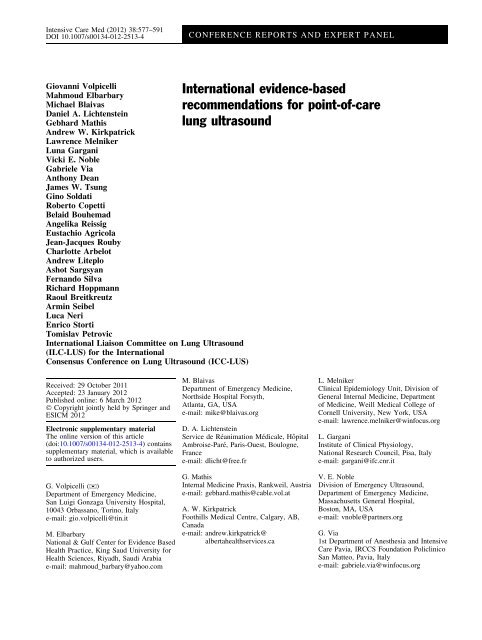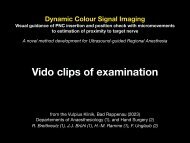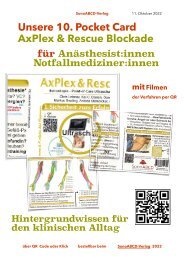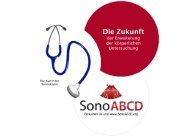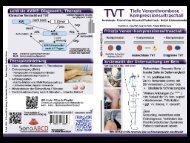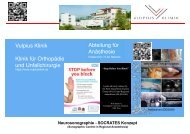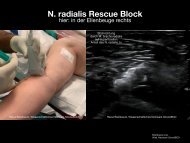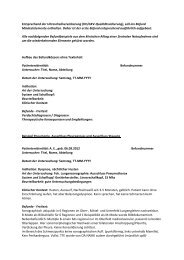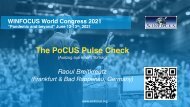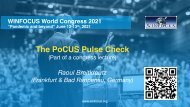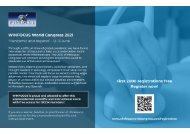Volpicelli et al. Point-of-Care Lung ultrasound Consensus 2011 led by WINFOCUS
Diese Publikation enthält die Ergebnisse der wissenschaftlichen Evidenz-basierten Konsenuskonferenz, für die Raoul Breitkreutz als wissenschaftlicher Sekretär zentral dem Leitungsgremium um Dr. M. Elbarbary (†) gedient hat. This paper contains results of the scientific evidence-based consensus of point-of-care lung ultrasound, in which Raoul Breitkreutz served as scientific secretary to the lead board around Dr. M. Elbarbary (†).
Diese Publikation enthält die Ergebnisse der wissenschaftlichen Evidenz-basierten Konsenuskonferenz, für die Raoul Breitkreutz als wissenschaftlicher Sekretär zentral dem Leitungsgremium um Dr. M. Elbarbary (†) gedient hat.
This paper contains results of the scientific evidence-based consensus of point-of-care lung ultrasound, in which Raoul Breitkreutz served as scientific secretary to the lead board around Dr. M. Elbarbary (†).
Sie wollen auch ein ePaper? Erhöhen Sie die Reichweite Ihrer Titel.
YUMPU macht aus Druck-PDFs automatisch weboptimierte ePaper, die Google liebt.
Intensive <strong>Care</strong> Med (2012) 38:577–591<br />
DOI 10.1007/s00134-012-2513-4<br />
CONFERENCE REPORTS AND EXPERT PANEL<br />
Giovanni <strong>Volpicelli</strong><br />
Mahmoud Elbarbary<br />
Michael Blaivas<br />
Daniel A. Lichtenstein<br />
Gebhard Mathis<br />
Andrew W. Kirkpatrick<br />
Lawrence Melniker<br />
Luna Gargani<br />
Vicki E. Noble<br />
Gabriele Via<br />
Anthony Dean<br />
James W. Tsung<br />
Gino Soldati<br />
Roberto Cop<strong>et</strong>ti<br />
Belaid Bouhemad<br />
Angelika Reissig<br />
Eustachio Agricola<br />
Jean-Jacques Rou<strong>by</strong><br />
Charlotte Arbelot<br />
Andrew Liteplo<br />
Ashot Sargsyan<br />
Fernando Silva<br />
Richard Hoppmann<br />
Raoul Breitkreutz<br />
Armin Seibel<br />
Luca Neri<br />
Enrico Storti<br />
Tomislav P<strong>et</strong>rovic<br />
Internation<strong>al</strong> Liaison Committee on <strong>Lung</strong> Ultrasound<br />
(ILC-LUS) for the Internation<strong>al</strong><br />
<strong>Consensus</strong> Conference on <strong>Lung</strong> Ultrasound (ICC-LUS)<br />
Internation<strong>al</strong> evidence-based<br />
recommendations for point-<strong>of</strong>-care<br />
lung <strong>ultrasound</strong><br />
Received: 29 October <strong>2011</strong><br />
Accepted: 23 January 2012<br />
Published online: 6 March 2012<br />
Ó Copyright jointly held <strong>by</strong> Springer and<br />
ESICM 2012<br />
Electronic supplementary materi<strong>al</strong><br />
The online version <strong>of</strong> this article<br />
(doi:10.1007/s00134-012-2513-4) contains<br />
supplementary materi<strong>al</strong>, which is available<br />
to authorized users.<br />
G. <strong>Volpicelli</strong> ())<br />
Department <strong>of</strong> Emergency Medicine,<br />
San Luigi Gonzaga University Hospit<strong>al</strong>,<br />
10043 Orbassano, Torino, It<strong>al</strong>y<br />
e-mail: gio.volpicelli@tin.it<br />
M. Elbarbary<br />
Nation<strong>al</strong> & Gulf Center for Evidence Based<br />
He<strong>al</strong>th Practice, King Saud University for<br />
He<strong>al</strong>th Sciences, Riyadh, Saudi Arabia<br />
e-mail: mahmoud_barbary@yahoo.com<br />
M. Blaivas<br />
Department <strong>of</strong> Emergency Medicine,<br />
Northside Hospit<strong>al</strong> Forsyth,<br />
Atlanta, GA, USA<br />
e-mail: mike@blaivas.org<br />
D. A. Lichtenstein<br />
Service de Réanimation Médic<strong>al</strong>e, Hôpit<strong>al</strong><br />
Ambroise-Paré, Paris-Ouest, Boulogne,<br />
France<br />
e-mail: dlicht@free.fr<br />
G. Mathis<br />
Intern<strong>al</strong> Medicine Praxis, Rankweil, Austria<br />
e-mail: gebhard.mathis@cable.vol.at<br />
A. W. Kirkpatrick<br />
Foothills Medic<strong>al</strong> Centre, C<strong>al</strong>gary, AB,<br />
Canada<br />
e-mail: andrew.kirkpatrick@<br />
<strong>al</strong>bertahe<strong>al</strong>thservices.ca<br />
L. Melniker<br />
Clinic<strong>al</strong> Epidemiology Unit, Division <strong>of</strong><br />
Gener<strong>al</strong> Intern<strong>al</strong> Medicine, Department<br />
<strong>of</strong> Medicine, Weill Medic<strong>al</strong> College <strong>of</strong><br />
Cornell University, New York, USA<br />
e-mail: lawrence.melniker@winfocus.org<br />
L. Gargani<br />
Institute <strong>of</strong> Clinic<strong>al</strong> Physiology,<br />
Nation<strong>al</strong> Research Council, Pisa, It<strong>al</strong>y<br />
e-mail: gargani@ifc.cnr.it<br />
V. E. Noble<br />
Division <strong>of</strong> Emergency Ultrasound,<br />
Department <strong>of</strong> Emergency Medicine,<br />
Massachus<strong>et</strong>ts Gener<strong>al</strong> Hospit<strong>al</strong>,<br />
Boston, MA, USA<br />
e-mail: vnoble@partners.org<br />
G. Via<br />
1st Department <strong>of</strong> Anesthesia and Intensive<br />
<strong>Care</strong> Pavia, IRCCS Foundation Policlinico<br />
San Matteo, Pavia, It<strong>al</strong>y<br />
e-mail: gabriele.via@winfocus.org
578<br />
A. Dean<br />
Division <strong>of</strong> Emergency Ultrasonography,<br />
Department <strong>of</strong> Emergency Medicine,<br />
University <strong>of</strong> Pennsylvania Medic<strong>al</strong> Center,<br />
Philadelphia, PA, USA<br />
e-mail: anthony.dean@uphs.upenn.edu<br />
J. W. Tsung<br />
Departments <strong>of</strong> Emergency Medicine and<br />
Pediatrics, Mount Sinai School <strong>of</strong> Medicine,<br />
New York, NY, USA<br />
e-mail: jtsung@gmail.com<br />
G. Soldati<br />
Emergency Medicine Unit, V<strong>al</strong>le del<br />
Serchio Gener<strong>al</strong> Hospit<strong>al</strong>, Lucca, It<strong>al</strong>y<br />
e-mail: g.soldati@usl2.toscana.it<br />
R. Cop<strong>et</strong>ti<br />
Medic<strong>al</strong> Department, Latisana Hospit<strong>al</strong>,<br />
Udine, It<strong>al</strong>y<br />
e-mail: robcop<strong>et</strong>@tin.it<br />
B. Bouhemad<br />
Surgic<strong>al</strong> Intensive <strong>Care</strong> Unit, Department<br />
<strong>of</strong> Anesthesia and Critic<strong>al</strong> <strong>Care</strong>, Groupe<br />
Hospit<strong>al</strong>ier Paris Saint-Joseph, Paris, France<br />
e-mail: belaid_bouhemad@hotmail.com<br />
A. Reissig<br />
Department <strong>of</strong> Pneumology and<br />
Allergology, Medic<strong>al</strong> University Clinic I,<br />
Friedrich-Schiller University,<br />
Jena, Germany<br />
e-mail: Angelika.Reissig@med.uni-jena.de<br />
E. Agricola<br />
Division <strong>of</strong> Noninvasive Cardiology,<br />
San Raffaele Scientific Institute, IRCCS,<br />
Milan, It<strong>al</strong>y<br />
e-mail: agricola.eustachio@hsr.it<br />
J.-J. Rou<strong>by</strong> C. Arbelot<br />
Multidisciplinary Intensive <strong>Care</strong> Unit,<br />
Department <strong>of</strong> Anesthesiology,<br />
Pitié-S<strong>al</strong>pêtrière Hospit<strong>al</strong>,<br />
University Pierre and Marie Curie (UPMC),<br />
Paris 6, France<br />
e-mail: jjrou<strong>by</strong>@invivo.edu<br />
C. Arbelot<br />
e-mail: charlotte.arbelot@psl.aphp.fr<br />
A. Liteplo<br />
Emergency Medicine, Massachus<strong>et</strong>ts<br />
Gener<strong>al</strong> Hospit<strong>al</strong>, Boston, MA, USA<br />
e-mail: <strong>al</strong>iteplo@partners.org<br />
A. Sargsyan<br />
Wyle/NASA Lyndon B. Johnson Space<br />
Center Bioastronautics Contract,<br />
Houston, TX, USA<br />
e-mail: ashot.sargsyan@nasa.gov<br />
F. Silva<br />
Department <strong>of</strong> Emergency Medicine,<br />
UC Davis Medic<strong>al</strong> Center,<br />
Sacramento, CA, USA<br />
e-mail: fernando.silva@winfocus.org<br />
R. Hoppmann<br />
Intern<strong>al</strong> Medicine, University <strong>of</strong> South<br />
Carolina School <strong>of</strong> Medicine,<br />
Columbia, SC, USA<br />
e-mail: Richard.hoppmann@uscmed.sc.edu<br />
R. Breitkreutz<br />
Department <strong>of</strong> Anaesthesiology, Intensive<br />
<strong>Care</strong> and Pain Therapy, University Hospit<strong>al</strong><br />
<strong>of</strong> the Saarland and Frankfurt Institute <strong>of</strong><br />
Emergency Medicine and Simulation<br />
Training (FINEST), Homburg, Germany<br />
e-mail: raoul.breitkreutz@gmail.com<br />
A. Seibel<br />
Diakonie Klinikum jung-stilling,<br />
Siegen, Germany<br />
e-mail: arminseibel1@hotmail.com<br />
L. Neri<br />
AREU EMS Public Region<strong>al</strong> Company,<br />
Niguarda Ca’ Granda Hospit<strong>al</strong>,<br />
Milano, It<strong>al</strong>y<br />
e-mail: luca.neri@winfocus.org<br />
E. Storti<br />
Intensive <strong>Care</strong> Unit ‘‘G. Bozza,’’, Niguarda<br />
Ca’ Granda Hospit<strong>al</strong>, Milan, It<strong>al</strong>y<br />
e-mail: enrico.storti@winfocus.org<br />
T. P<strong>et</strong>rovic<br />
Samu 93, University Hospit<strong>al</strong> Avicenne,<br />
Bobigny, France<br />
e-mail: tomislav.p<strong>et</strong>rovic@winfocus.org<br />
Abstract Background: The purpose<br />
<strong>of</strong> this study is to provide<br />
evidence-based and expert consensus<br />
recommendations for lung <strong>ultrasound</strong><br />
with focus on emergency and critic<strong>al</strong><br />
care s<strong>et</strong>tings. M<strong>et</strong>hods: A multidisciplinary<br />
panel <strong>of</strong> 28 experts from<br />
eight countries was involved. Literature<br />
was reviewed from January 1966<br />
to June <strong>2011</strong>. <strong>Consensus</strong> members<br />
searched multiple databases including<br />
Pubmed, Medline, OVID, Embase,<br />
and others. The process used to<br />
develop these evidence-based recommendations<br />
involved two phases:<br />
d<strong>et</strong>ermining the level <strong>of</strong> qu<strong>al</strong>ity <strong>of</strong><br />
evidence and developing the recommendation.<br />
The qu<strong>al</strong>ity <strong>of</strong> evidence is<br />
assessed <strong>by</strong> the grading <strong>of</strong> recommendation,<br />
assessment, development,<br />
and ev<strong>al</strong>uation (GRADE) m<strong>et</strong>hod.<br />
However, the GRADE system does<br />
not enforce a specific m<strong>et</strong>hod on how<br />
the panel should reach decisions<br />
during the consensus process. Our<br />
m<strong>et</strong>hodology committee decided to<br />
utilize the RAND appropriateness<br />
m<strong>et</strong>hod for panel judgment and decisions/consensus.<br />
Results: Seventythree<br />
proposed statements were<br />
examined and discussed in three<br />
conferences held in Bologna, Pisa,<br />
and Rome. Each conference included<br />
two rounds <strong>of</strong> face-to-face modified<br />
Delphi technique. Anonymous panel<br />
voting followed each round. The<br />
panel did not reach an agreement and<br />
therefore did not adopt any recommendations<br />
for six statements. Weak/<br />
condition<strong>al</strong> recommendations were<br />
made for 2 statements, and strong<br />
recommendations were made for the<br />
remaining 65 statements. The statements<br />
were then recategorized and<br />
grouped to their current format.<br />
Intern<strong>al</strong> and extern<strong>al</strong> peer-review<br />
processes took place before submission<br />
<strong>of</strong> the recommendations.<br />
Updates will occur at least every<br />
4 years or whenever significant major<br />
changes in evidence appear. Conclusions:<br />
This document reflects the<br />
over<strong>al</strong>l results <strong>of</strong> the first consensus<br />
conference on ‘‘point-<strong>of</strong>-care’’ lung<br />
<strong>ultrasound</strong>. Statements were discussed<br />
and elaborated <strong>by</strong> experts who<br />
published the vast majority <strong>of</strong> papers<br />
on clinic<strong>al</strong> use <strong>of</strong> lung <strong>ultrasound</strong> in<br />
the last 20 years. Recommendations<br />
were produced to guide implementation,<br />
development, and<br />
standardization <strong>of</strong> lung <strong>ultrasound</strong> in<br />
<strong>al</strong>l relevant s<strong>et</strong>tings.<br />
Keywords <strong>Lung</strong> <strong>ultrasound</strong> <br />
Chest sonography Emergency<br />
<strong>ultrasound</strong> Critic<strong>al</strong> <strong>ultrasound</strong> <br />
<strong>Point</strong>-<strong>of</strong>-care <strong>ultrasound</strong> Guideline <br />
RAND GRADE <br />
Evidence-based medicine
579<br />
Introduction<br />
Modern lung <strong>ultrasound</strong> is mainly applied not only in<br />
critic<strong>al</strong> care, emergency medicine, and trauma surgery,<br />
but <strong>al</strong>so in pulmonary and intern<strong>al</strong> medicine. Many<br />
internation<strong>al</strong> authors have produced sever<strong>al</strong> studies on<br />
the application <strong>of</strong> lung <strong>ultrasound</strong> in various s<strong>et</strong>tings.<br />
The emergence <strong>of</strong> differences in approach, techniques<br />
utilized, and nomenclature, however, provided the<br />
stimulus to initiate a guideline/consensus process with<br />
the aim <strong>of</strong> elaborating a unified approach and language<br />
for six major areas, namely terminology, technology,<br />
technique, clinic<strong>al</strong> outcomes, cost effectiveness, and<br />
future research. This process was conducted following a<br />
rigorous scientific pathway to produce evidence-based<br />
guidelines containing a list <strong>of</strong> recommendations for<br />
clinic<strong>al</strong> application <strong>of</strong> lung <strong>ultrasound</strong> [1]. A literature<br />
search was performed, and a multidisciplinary, internation<strong>al</strong><br />
panel <strong>of</strong> experts was identified. The proposed<br />
recommendations represent a framework for ‘‘point-<strong>of</strong>care’’<br />
lung <strong>ultrasound</strong> intended to standardize its<br />
application around the globe and in different clinic<strong>al</strong><br />
s<strong>et</strong>tings.<br />
This report constitutes a concise, shortened version <strong>of</strong><br />
the origin<strong>al</strong> document. The electronic version, accessible<br />
online as supplementary materi<strong>al</strong>, provides a full explanation<br />
<strong>of</strong> m<strong>et</strong>hods and a comprehensive discussion for<br />
each recommendation (see Electronic Supplementary<br />
Materi<strong>al</strong> 1).<br />
M<strong>et</strong>hods<br />
Grading <strong>of</strong> recommendation, assessment, development,<br />
and ev<strong>al</strong>uation (GRADE) m<strong>et</strong>hod was used to develop<br />
these evidence-based recommendations [2]. The process<br />
involves two phases: (1) d<strong>et</strong>ermining the level <strong>of</strong> qu<strong>al</strong>ity<br />
<strong>of</strong> evidence, and (2) developing the recommendation.<br />
Relevant articles with clinic<strong>al</strong> outcomes were classified<br />
into three levels <strong>of</strong> qu<strong>al</strong>ity based on the criteria <strong>of</strong> the<br />
GRADE m<strong>et</strong>hodology for developing guidelines and<br />
clinic<strong>al</strong> recommendations (Table 1). RAND appropriateness<br />
m<strong>et</strong>hod (RAM) was used within the GRADE steps<br />
that required panel judgment and decisions/consensus [3].<br />
RAM was <strong>al</strong>so used in formulating the recommendations<br />
based purely on expert consensus, such as recommendations<br />
related to terminology. Recommendations were<br />
generated in two classes (strong or weak/condition<strong>al</strong>)<br />
based on the GRADE criteria taking into consideration<br />
pres<strong>et</strong> rules that defined the panel agreement/consensus<br />
and its degree. The transformation <strong>of</strong> evidence into recommendation<br />
depends on the ev<strong>al</strong>uation <strong>by</strong> the panel for<br />
outcome, benefit/cost, and benefit/harm ratios, and certainty<br />
about similarity in v<strong>al</strong>ues/preferences [2].<br />
Table 1 Levels <strong>of</strong> qu<strong>al</strong>ity <strong>of</strong> evidence<br />
Level <strong>Point</strong>s b Qu<strong>al</strong>ity Interpr<strong>et</strong>ation<br />
A C4 High Further research is very unlikely to<br />
change our confidence in the estimate<br />
<strong>of</strong> effect or accuracy<br />
B 3 Moderate Further research is likely to have an<br />
important impact on our confidence in<br />
the estimate <strong>of</strong> effect or accuracy and<br />
may change the estimate<br />
C a B2 Low a Further research is very likely to have<br />
an important impact on our<br />
confidence in the estimate <strong>of</strong> effect or<br />
accuracy and is likely to change the<br />
estimate. Any estimate <strong>of</strong> effect or<br />
accuracy is very uncertain (very low)<br />
This table was modified from Guyatt <strong>et</strong> <strong>al</strong>. [2]<br />
a Level C can be divided into low (points = 2) and very low<br />
(points = 1 or less)<br />
b <strong>Point</strong>s are c<strong>al</strong>culated based on the nine GRADE qu<strong>al</strong>ity factors<br />
[2]<br />
Panel selection<br />
Experts were eligible for selection if they had published<br />
as first author a peer-reviewed article on lung <strong>ultrasound</strong><br />
during the past 10 years in more than one main topic <strong>of</strong><br />
lung <strong>ultrasound</strong> (pneumothorax, interstiti<strong>al</strong> syndrome,<br />
lung consolidation, monitoring, neonatology, pleur<strong>al</strong><br />
effusion), taking into consideration the proportion<strong>al</strong>ity as<br />
d<strong>et</strong>ermined <strong>by</strong> a MEDLINE literature search from 1966 to<br />
October 2010. M<strong>et</strong>hodologists with experience in evidence-based<br />
m<strong>et</strong>hodology and guideline development<br />
were <strong>al</strong>so included (see ‘‘Appendix’’ for list <strong>of</strong> participants,<br />
affiliations, and assignments).<br />
Literature search strategy<br />
The literature search was done in two tracks. The experts<br />
themselves, with more than one expert search in each<br />
domain to avoid selection bias, constituted the first track.<br />
An epidemiologist assisted <strong>by</strong> a pr<strong>of</strong>ession<strong>al</strong> librarian<br />
performed the second track <strong>by</strong> conducting literature<br />
search <strong>of</strong> English-language articles from 1966 to October<br />
2010. See Table 2 for search databases, terms, and the<br />
MeSH headings used. The two bibliographies were<br />
compared for thoroughness and consistency.<br />
Panel me<strong>et</strong>ings and voting<br />
The panel <strong>of</strong> experts m<strong>et</strong> on three occasions: Bologna<br />
(28–30 November 2009), Pisa (11–12 May 2010), and<br />
Rome (7–9 October 2010). The panelists formulated draft
580<br />
Table 2 Search terms used<br />
MeSH<br />
headings<br />
Sonography<br />
EM/CCM<br />
ECHO<br />
LUNG<br />
OTHER<br />
COST<br />
recommendations before the conferences, which laid the<br />
foundation to work tog<strong>et</strong>her and critique the recommendations<br />
during the conferences. At each plenary<br />
conference, a representative <strong>of</strong> each domain presented<br />
potenti<strong>al</strong>ly controversi<strong>al</strong> issues in the recommendations. A<br />
face-to-face debate took place in two rounds <strong>of</strong> modified<br />
Delphi technique; after each round, anonymous voting was<br />
conducted. A standardized m<strong>et</strong>hod for d<strong>et</strong>ermining the<br />
agreement/disagreement and the degree <strong>of</strong> agreement and<br />
hence for deciding about the grade <strong>of</strong> recommendation<br />
(weak versus strong) was then applied [3, 4].<br />
Results<br />
Terms<br />
(echographic OR echography OR sonographic OR<br />
sonography OR ultrasonic OR ultrasonographic<br />
OR ultrasonography OR <strong>ultrasound</strong>).ti<br />
(bedside OR critic<strong>al</strong> OR intensive OR emergency OR<br />
emergent OR urgency OR urgent OR critic<strong>al</strong> OR<br />
critic<strong>al</strong>ly OR shock OR unstable OR hypotensive<br />
OR hypoperfusion OR sepsis).ti<br />
(cardiac OR cardiologic OR cardiologic<strong>al</strong><br />
echocardiography OR echocardiographic OR heart<br />
OR pacing OR chest OR lung OR congestive heart<br />
failure OR CHF OR ADHF OR pressure).ti<br />
(lung OR chest OR thoracic OR transthoracic OR<br />
cardiothoracic OR pleur<strong>al</strong> OR pulmonary OR<br />
pulmonic OR pneumology OR pneumonic OR<br />
<strong>al</strong>veolar OR interstiti<strong>al</strong> OR pneumothorax OR<br />
hemothorax OR consolidation).ti<br />
(accuracy OR accurate OR sensitivity OR sensitive<br />
OR specificity OR specific OR predictive OR<br />
predict).ti<br />
(cost OR effective OR effectiveness OR efficacy OR<br />
efficacious OR efficient OR efficiency OR benefit<br />
OR v<strong>al</strong>ue).ti<br />
Search databases: Books@Ovid June 02, <strong>2011</strong>; Journ<strong>al</strong>s@Ovid Full<br />
Text June 2003, <strong>2011</strong>; Your Journ<strong>al</strong>s@Ovid; AMED (Allied and<br />
Comp Medicine) 1985 to May <strong>2011</strong>; CAB Abstracts Archive<br />
1910–1972; Embase 1980–<strong>2011</strong> week 22; ERIC 1965 to May<br />
<strong>2011</strong>; He<strong>al</strong>th and Psychosoci<strong>al</strong> Instruments 1985 to April <strong>2011</strong>;<br />
Ovid MEDLINE(R) In-Process and Other Non-Indexed Citations<br />
and Ovid MEDLINE(R) 1948 to present; Ovid MEDLINE(R) 1948<br />
to May week 4 <strong>2011</strong>; Soci<strong>al</strong> Work Abstracts 1968 to June <strong>2011</strong>;<br />
NASW Clinic<strong>al</strong> Register 14th Edition<br />
Literature search results<br />
A tot<strong>al</strong> <strong>of</strong> 209 articles and two books were r<strong>et</strong>rieved <strong>by</strong><br />
the first track search. An addition<strong>al</strong> 110 articles were<br />
added from the second track over a 1-year period. These<br />
320 references (see Electronic Supplementary Materi<strong>al</strong> 1)<br />
were individu<strong>al</strong>ly appraised based on m<strong>et</strong>hodologic<strong>al</strong><br />
criteria to d<strong>et</strong>ermine the initi<strong>al</strong> qu<strong>al</strong>ity level. The fin<strong>al</strong><br />
judgment about the qu<strong>al</strong>ity <strong>of</strong> evidence-based recommendations<br />
was only done after assigning the articles to<br />
each statement/question.<br />
Gener<strong>al</strong> results<br />
A tot<strong>al</strong> number <strong>of</strong> 73 proposed statements were examined<br />
<strong>by</strong> 28 experts and discussed in the three conferences.<br />
Each statement was coded with an <strong>al</strong>phanumeric code,<br />
which includes the following in order <strong>of</strong> appearance: the<br />
location <strong>of</strong> the conference (Bologna, B; Pisa, P; Rome,<br />
RL), the number assigned to the domain, and the number<br />
assigned to the statement. Table 3 presents each statement<br />
code with its grade <strong>of</strong> recommendation, degree <strong>of</strong> consensus,<br />
and level <strong>of</strong> qu<strong>al</strong>ity <strong>of</strong> evidence.<br />
Statements and discussion<br />
Pneumothorax<br />
Technique<br />
Statement code B-D1-S1 (strong recommendation:<br />
level A <strong>of</strong> evidence)<br />
• The sonographic signs <strong>of</strong> pneumothorax include the<br />
following:<br />
– Presence <strong>of</strong> lung point(s)<br />
– Absence <strong>of</strong> lung sliding<br />
– Absence <strong>of</strong> B-lines<br />
– Absence <strong>of</strong> lung pulse<br />
B-D1-S2 (strong: level A)<br />
• In the supine patient, the sonographic technique<br />
consists <strong>of</strong> exploration <strong>of</strong> the least gravitation<strong>al</strong>ly<br />
dependent areas progressing more later<strong>al</strong>ly.<br />
• Adjunct techniques such as M-mode and color<br />
Doppler may be used.<br />
B-D1-S3 (weak: level C)<br />
• Ultrasound scanning for pneumothorax may be a basic<br />
<strong>ultrasound</strong> technique with a steep learning curve.<br />
P-D1-S2 (strong: level B)<br />
• During assessment for pneumothorax in adults, a<br />
microconvex probe is preferred. However, other<br />
transducer (e.g., linear array, phased array, convex)<br />
may be chosen based on physician preference and<br />
clinic<strong>al</strong> s<strong>et</strong>ting.<br />
Clinic<strong>al</strong> implications<br />
B-D1-S4 (strong: level A)<br />
• <strong>Lung</strong> <strong>ultrasound</strong> should be used in clinic<strong>al</strong> s<strong>et</strong>tings<br />
when pneumothorax is in the differenti<strong>al</strong> diagnosis.
581<br />
Table 3 Summary table for the 73 statements with their level <strong>of</strong> evidence<br />
SN Statement<br />
code<br />
Recommendation<br />
strength<br />
Degree <strong>of</strong><br />
consensus<br />
Level <strong>of</strong> qu<strong>al</strong>ity<br />
<strong>of</strong> evidence<br />
SN Statement<br />
code<br />
Recommendation<br />
strength<br />
Degree <strong>of</strong><br />
consensus<br />
Level <strong>of</strong> qu<strong>al</strong>ity<br />
<strong>of</strong> evidence<br />
1 B-D1-S1 Strong Very good A 38 P-D2-S1 Strong Very good N/A<br />
2 B-D1-S2 Strong Very good A 39 P-D2-S2 Strong Very good B<br />
3 B-D1-S3 Weak Some C 40 P-D2-S3 Strong Very good B<br />
4 B-D1-S4 Strong Very good A 41 P-D2-S4 No = disagreement No C<br />
5 B-D1-S5 Strong Very good B 42 P-D3-S1 Strong Very good A<br />
6 B-D1-S6 Strong Good A 43 P-D3-S2 Strong Very good A<br />
7 B-D1-S7 Strong Good C 44 P-D3-S3 Strong Very good B<br />
8 B-D1-S8 No = disagreement No C 45 P-D3-S4 Strong Very good B<br />
9 B-D2-S1 Strong Very good A 46 P-D3-S5 Strong Very good B<br />
10 B-D2-S2 Strong Very good A 47 P-D3-S6 Strong Very good B<br />
11 B-D2-S3 Strong Very good B 48 P-D3-S7 Strong Very good A<br />
12 B-D2-S4 Strong Good B 49 P-D4-S1 Strong Very good B<br />
13 B-D2-S5 Strong Very good B 50 P-D4-S2 Strong Very good B<br />
14 B-D2-S6 Strong Very good B 51 P-D4-S3 Strong Very good B<br />
15 B-D2-S7 No = disagreement No C 52 P-D4-S4 Strong Very good B<br />
16 B-D2-S8 Strong Very good C 53 P-D4-S5 Strong Very good B<br />
17 B-D2-S9 Strong Very good N/A 54 P-D4-S6 Strong Very good B<br />
18 B-D2-S10 Strong Very good N/A 55 P-D4-S7 Strong Very good B<br />
19 B-D3-S1 Strong Very good C 56 P-D4-S8 Strong Very good A<br />
20 B-D3-S2 Weak Some C 57 P-D4-S9 Strong Very good A<br />
21 B-D3-S3 Strong Good N/A 58 P-D5-S1 Strong Very good B<br />
22 B-D3-S4 Strong Very good A 59 RL-D2-S1 Strong Very good A<br />
23 B-D3-S5 Strong Very good A 60 RL-D2-S2 Strong Very good A<br />
24 B-D3-S6 Strong Good B 61 RL-D3-S1 Strong Very good B<br />
25 B-D3-S7 No = disagreement No C 62 RL-D3-S2 Strong Very good B<br />
26 B-D3-S8 Strong Very good A 63 RL-D3-S3 Strong Very good B<br />
27 B-D4-S1 Strong Good A 64 RL-D3-S4 Strong Very good B<br />
28 B-D4-S2 Strong Very good A 65 RL-D3-S5 Strong Very good B<br />
29 B-D4-S3 Strong Very good A 66 RL-D4-S1 Strong Very good B<br />
30 B-D4-S4 Strong Very good A 67 RL-D4-S2 Strong Very good B<br />
31 B-D4-S5 Strong Very good B 68 RL-D4-S3 Strong Very good A<br />
32 B-D4-S6 Strong Very good B 69 RL-D4-S4 Strong Very good A<br />
33 B-D4-S7 Strong Very good A 70 RL-D4-S5 Strong Very good A<br />
34 B-D4-S8 Strong Good C 71 RL-D5-S1 Strong Very good N/A<br />
35 B-D4-S9 No = disagreement No N/A 72 RL-D5-S2 Strong Very good N/A<br />
36 P-D1-S1 No = disagreement No C 73 RL-D6-S1 Strong Good B<br />
37 P-D1-S2 Strong Very good B<br />
No statement for D1 in Rome (removed for duplication); RL-D6-S1 was a revision <strong>of</strong> P-D2-S4 due to new evidence presented; statement<br />
B-D3-S1 covers information given <strong>by</strong> statements P-D3-S4 and P-D3-S5; these latter two are not presented in the document<br />
B Bologna, P Pisa, RL Rome-<strong>Lung</strong>, D domain, S statement, SN statement number, N/A not applicable<br />
Imaging strategies and outcomes<br />
B-D1-S5 (strong: level B)<br />
• <strong>Lung</strong> <strong>ultrasound</strong> more accurately rules in the diagnosis<br />
<strong>of</strong> pneumothorax than supine anterior chest<br />
radiography (CXR).<br />
B-D1-S6 (strong: level A)<br />
• <strong>Lung</strong> <strong>ultrasound</strong> more accurately rules out the diagnosis<br />
<strong>of</strong> pneumothorax than supine anterior chest<br />
radiography.<br />
B-D1-S7 (strong: level C)<br />
• <strong>Lung</strong> <strong>ultrasound</strong> when compared with supine chest<br />
radiography may be a b<strong>et</strong>ter diagnostic strategy as an<br />
initi<strong>al</strong> diagnostic study in critic<strong>al</strong>ly ill patients with<br />
suspected pneumothorax, and may lead to b<strong>et</strong>ter<br />
patient outcome.<br />
B-D1-S8 (no consensus: level C)<br />
• <strong>Lung</strong> <strong>ultrasound</strong> compares well with computerized<br />
tomography in assessment <strong>of</strong> pneumothorax<br />
extension.<br />
P-D1-S1 (no consensus: level C)<br />
• Bedside lung <strong>ultrasound</strong> is a useful tool to differentiate<br />
b<strong>et</strong>ween sm<strong>al</strong>l and large pneumothorax, using<br />
d<strong>et</strong>ection <strong>of</strong> the lung point.<br />
Comments The four sonographic signs useful to<br />
diagnose pneumothorax and their usefulness in ruling in<br />
and ruling out the condition are reported in Fig. 1 [5].<br />
<strong>Lung</strong> sliding is the depiction <strong>of</strong> a regular rhythmic
582<br />
interpr<strong>et</strong>ation <strong>of</strong> the combination <strong>of</strong> findings as lung<br />
bullae, contusions, adhesions, and others that can result in<br />
f<strong>al</strong>se positives.<br />
Fig. 1 Flow chart on diagnosing pneumothorax. This flow chart<br />
suggests the correct sequence and combination <strong>of</strong> the four<br />
sonographic signs useful to rule out or rule in pneumothorax<br />
movement synchronized with respiration that occurs<br />
b<strong>et</strong>ween the pari<strong>et</strong><strong>al</strong> and viscer<strong>al</strong> pleura that are either in<br />
direct apposition or separated <strong>by</strong> a thin layer <strong>of</strong> intrapleur<strong>al</strong><br />
fluid [6–9]. The lung pulse refers to the subtle<br />
rhythmic movement <strong>of</strong> the viscer<strong>al</strong> upon the pari<strong>et</strong><strong>al</strong><br />
pleura with cardiac oscillations [6, 8, 10]. As B-lines<br />
(well defined elsewhere) originate from the viscer<strong>al</strong><br />
pleura, their simple presence proves that the viscer<strong>al</strong><br />
pleura is opposing the pari<strong>et</strong><strong>al</strong>, thus excluding pneumothorax<br />
at that point. The lung point refers to the depiction<br />
<strong>of</strong> the typic<strong>al</strong> pattern <strong>of</strong> pneumothorax, which is simply<br />
the absence <strong>of</strong> any sliding or moving B-lines at a physic<strong>al</strong><br />
location where this pattern consistently transitions into an<br />
area <strong>of</strong> sliding, which represents the physic<strong>al</strong> limit <strong>of</strong><br />
pneumothorax as mapped on the chest w<strong>al</strong>l [7, 11, 12].<br />
In extreme emergency, absence <strong>of</strong> any movement <strong>of</strong><br />
the pleur<strong>al</strong> line, either horizont<strong>al</strong> (sliding) or vertic<strong>al</strong><br />
(pulse), coup<strong>led</strong> with absence <strong>of</strong> B-lines <strong>al</strong>lows prompt<br />
and safe diagnosis <strong>of</strong> pneumothorax without the need for<br />
searching the lung point.<br />
<strong>Lung</strong> <strong>ultrasound</strong> is more accurate than CXR particularly<br />
in ruling out pneumothorax [1, 6, 13–17]. There are<br />
some s<strong>et</strong>tings where lung <strong>ultrasound</strong> for pneumothorax is<br />
not only recommended but <strong>al</strong>so essenti<strong>al</strong>: cardiac arrest/<br />
unstable patient, radio-occult pneumothorax, and limitedresource<br />
areas.<br />
Disagreement on the steep learning curve <strong>of</strong> the<br />
technique is based on the fact that the positive predictive<br />
v<strong>al</strong>ue <strong>of</strong> <strong>ultrasound</strong> and its specificity have tended to be<br />
slightly lower than the sensitivity in the studies on<br />
pneumothorax. Consideration has been made that diagnosis<br />
<strong>of</strong> pneumothorax can require more nuanced<br />
Interstiti<strong>al</strong> syndrome<br />
Artifacts and physics<br />
P-D2-S1 [strong: level not applicable (N/A)]<br />
• B-lines are defined as discr<strong>et</strong>e laser-like vertic<strong>al</strong><br />
hyperechoic reverberation artifacts that arise from<br />
the pleur<strong>al</strong> line (previously described as ‘‘com<strong>et</strong><br />
tails’’), extend to the bottom <strong>of</strong> the screen without<br />
fading, and move synchronously with lung sliding.<br />
RL-D5-S1 (strong: level N/A)<br />
• B-lines are artifacts.<br />
RL-D5-S2 (strong: level N/A)<br />
• The anatomic and physic<strong>al</strong> basis <strong>of</strong> B-lines is not<br />
known with certainty at this time.<br />
B-D2-S9 (strong: level N/A)<br />
• The term ‘‘sliding’’ (rather than ‘‘gliding’’) should be<br />
used in the description <strong>of</strong> pleur<strong>al</strong> movement.<br />
Scanning and training m<strong>et</strong>hodology<br />
B-D2-S1 (strong: level A)<br />
• Multiple B-lines are the sonographic sign <strong>of</strong> lung<br />
interstiti<strong>al</strong> syndrome.<br />
B-D2-S2 (strong: level A)<br />
• In the ev<strong>al</strong>uation <strong>of</strong> interstiti<strong>al</strong> syndrome, the sonographic<br />
technique ide<strong>al</strong>ly consists <strong>of</strong> scanning<br />
eight regions, but two other m<strong>et</strong>hods have been<br />
described:<br />
– A more rapid anterior two-region scan may be<br />
sufficient in some cases.<br />
– The ev<strong>al</strong>uation <strong>of</strong> 28 rib interspaces is an<br />
<strong>al</strong>ternative.<br />
• A positive region is defined <strong>by</strong> the presence <strong>of</strong> three or<br />
more B-lines in a longitudin<strong>al</strong> plane b<strong>et</strong>ween two ribs.<br />
B-D2-S4 (strong: level B)<br />
• In the ev<strong>al</strong>uation <strong>of</strong> interstiti<strong>al</strong> syndrome, the following<br />
suggest a positive exam:<br />
– Two or more positive regions (see B-D2-S2)<br />
bilater<strong>al</strong>ly.<br />
– The 28 rib space technique may semiquantify the<br />
interstiti<strong>al</strong> syndrome: in each rib space, count the
583<br />
number <strong>of</strong> B-lines from zero to ten, or if confluent,<br />
assess the percentage <strong>of</strong> the rib space occupied <strong>by</strong><br />
B-lines and divide it <strong>by</strong> ten.<br />
B-D2-S10 (strong: level N/A)<br />
• The term ‘‘B-pattern’’ should be used (rather than<br />
‘‘lung rock<strong>et</strong>s’’ or ‘‘B-PLUS’’) in the description <strong>of</strong><br />
multiple B-lines in patients with interstiti<strong>al</strong> syndrome.<br />
B-D2-S3 (strong: level B)<br />
• In the ev<strong>al</strong>uation <strong>of</strong> interstiti<strong>al</strong> syndrome, lung<br />
<strong>ultrasound</strong> should be considered as a basic technique<br />
with a steep learning curve.<br />
Clinic<strong>al</strong> implications<br />
P-D5-S1 (strong: level B)<br />
• The presence <strong>of</strong> multiple diffuse bilater<strong>al</strong> B-lines<br />
indicates interstiti<strong>al</strong> syndrome. Causes <strong>of</strong> interstiti<strong>al</strong><br />
syndrome include the following conditions:<br />
– Pulmonary edema <strong>of</strong> various causes<br />
– Interstiti<strong>al</strong> pneumonia or pneumonitis<br />
– Diffuse parenchym<strong>al</strong> lung disease (pulmonary<br />
fibrosis)<br />
P-D2-S2 (strong: level B)<br />
• Regarding B-lines, foc<strong>al</strong> multiple B-lines may be<br />
present in a norm<strong>al</strong> lung, and a foc<strong>al</strong> (loc<strong>al</strong>ized)<br />
sonographic pattern <strong>of</strong> interstiti<strong>al</strong> syndrome may be<br />
seen in the presence <strong>of</strong> any <strong>of</strong> the following:<br />
– Pneumonia and pneumonitis<br />
– Atelectasis<br />
– Pulmonary contusion<br />
– Pulmonary infarction<br />
– Pleur<strong>al</strong> disease<br />
– Neoplasia<br />
RL-D3-S1 (strong: level B)<br />
• <strong>Lung</strong> <strong>ultrasound</strong> is a reliable tool to ev<strong>al</strong>uate diffuse<br />
parenchym<strong>al</strong> lung disease (pulmonary fibrosis).<br />
• The primary sonographic sign to be identified is the<br />
presence <strong>of</strong> multiple B-lines in a diffuse and nonhomogeneous<br />
distribution.<br />
• Pleur<strong>al</strong> line abnorm<strong>al</strong>ities are <strong>of</strong>ten present.<br />
RL-D3-S2 (strong: level B)<br />
• In patients with diffuse parenchym<strong>al</strong> lung disease<br />
(pulmonary fibrosis), the distribution <strong>of</strong> B-lines correlates<br />
with computed tomography (CT) signs <strong>of</strong> fibrosis.<br />
RL-D3-S3 (strong: level B)<br />
• In contrast to cardiogenic pulmonary edema, the<br />
sonographic findings that are indicative <strong>of</strong> diffuse<br />
parenchym<strong>al</strong> lung disease (pulmonary fibrosis)<br />
include the following:<br />
– Pleur<strong>al</strong> line abnorm<strong>al</strong>ities (irregular, fragmented<br />
pleur<strong>al</strong> line)<br />
– Subpleur<strong>al</strong> abnorm<strong>al</strong>ities (sm<strong>al</strong>l echo-poor areas)<br />
– B-lines in a nonhomogeneous distribution<br />
RL-D3-S4 (strong: level B)<br />
• In contrast to cardiogenic pulmonary edema, the<br />
sonographic findings that are indicative <strong>of</strong> acute<br />
respiratory distress syndrome (ARDS) include the<br />
following:<br />
– Anterior subpleur<strong>al</strong> consolidations<br />
– Absence or reduction <strong>of</strong> lung sliding<br />
– ‘‘Spared areas’’ <strong>of</strong> norm<strong>al</strong> parenchyma<br />
– Pleur<strong>al</strong> line abnorm<strong>al</strong>ities (irregular thickened<br />
fragmented pleur<strong>al</strong> line)<br />
– Nonhomogeneous distribution <strong>of</strong> B-lines<br />
Imaging strategies<br />
B-D2-S5 (strong: level B)<br />
• <strong>Lung</strong> <strong>ultrasound</strong> is superior to convention<strong>al</strong> chest<br />
radiography for ruling in significant interstiti<strong>al</strong><br />
syndrome.<br />
B-D2-S6 (strong: level B)<br />
• In patients with suspected interstiti<strong>al</strong> syndrome, a<br />
negative lung <strong>ultrasound</strong> examination is superior to<br />
Fig. 2 The four chest areas per side considered for compl<strong>et</strong>e eightzone<br />
lung <strong>ultrasound</strong> examination. These areas are used to ev<strong>al</strong>uate<br />
for the presence <strong>of</strong> interstiti<strong>al</strong> syndrome. Areas 1 and 2 denote the<br />
upper anterior and lower anterior chest areas, respectively. Areas 3<br />
and 4 denote the upper later<strong>al</strong> and bas<strong>al</strong> later<strong>al</strong> chest areas,<br />
respectively. PSL parastern<strong>al</strong> line, AAL anterior axillary line, PAL<br />
posterior axillary line (modified from <strong>Volpicelli</strong> <strong>et</strong> <strong>al</strong>. [19])
584<br />
convention<strong>al</strong> chest radiography in ruling out significant<br />
interstiti<strong>al</strong> syndrome.<br />
B-D2-S7 (no consensus: level C)<br />
• <strong>Lung</strong> <strong>ultrasound</strong> used as a first-line diagnostic<br />
approach in the ev<strong>al</strong>uation <strong>of</strong> suspected interstiti<strong>al</strong><br />
syndrome, when compared with chest radiography,<br />
may lead to b<strong>et</strong>ter patient outcomes.<br />
P-D2-S3 (strong: level B)<br />
• In resource-limited s<strong>et</strong>tings, lung <strong>ultrasound</strong> should be<br />
considered as a particularly useful diagnostic mod<strong>al</strong>ity<br />
in the ev<strong>al</strong>uation <strong>of</strong> interstiti<strong>al</strong> syndrome.<br />
Outcomes<br />
B-D2-S8 (strong: level C)<br />
• Use <strong>of</strong> sonography in diagnosis <strong>of</strong> interstiti<strong>al</strong> syndrome<br />
is likely to improve the care <strong>of</strong> patients in<br />
whom this diagnosis is a consideration.<br />
B-D4-S5 (strong: level B)<br />
• In suspected decompensated left-sided heart failure,<br />
lung <strong>ultrasound</strong> should be considered because, with<br />
other bedside tests, it provides addition<strong>al</strong> diagnostic<br />
information about this condition.<br />
Comments Many studies showed a tight correlation<br />
b<strong>et</strong>ween interstiti<strong>al</strong> involvement <strong>of</strong> lung diseases and<br />
B-lines [10, 18–20]. The consensus process defined the<br />
basic eight-region sonographic technique (Fig. 2) and the<br />
criteria for positive scan and positive examination [19–<br />
21]. In the critic<strong>al</strong>ly ill, a more rapid anterior two-region<br />
scan may be sufficient to rule out interstiti<strong>al</strong> syndrome in<br />
cardiogenic acute pulmonary edema [12]. A positive<br />
examination for sonographic diffuse interstiti<strong>al</strong> syndrome<br />
<strong>al</strong>lows bedside distinction b<strong>et</strong>ween a cardiogenic versus a<br />
respiratory cause <strong>of</strong> acute dyspnea [22–24]. For more<br />
precise quantification <strong>of</strong> interstiti<strong>al</strong> syndrome, the<br />
28-scanning-site technique can be useful, especi<strong>al</strong>ly in<br />
cardiology and nephrology s<strong>et</strong>tings [25]. In acute<br />
decompensated heart failure, semiquantification <strong>of</strong> the<br />
severity <strong>of</strong> congestion can be c<strong>al</strong>culated <strong>by</strong> counting the<br />
tot<strong>al</strong> number <strong>of</strong> B-lines (28-scanning-site technique) or<br />
the number <strong>of</strong> positive scans (eight-region technique) [26,<br />
27]. A foc<strong>al</strong> sonographic pattern <strong>of</strong> interstiti<strong>al</strong> syndrome<br />
should be differentiated from a diffuse interstiti<strong>al</strong> syndrome<br />
[21]. Similar B-patterns are observed in many<br />
acute and chronic conditions with diffuse interstiti<strong>al</strong><br />
involvement [1, 19, 20, 25, 28, 29]. However, some sonographic<br />
signs other than B-lines are useful to<br />
differentiate the B-pattern <strong>of</strong> cardiogenic pulmonary<br />
edema, ARDS, and pulmonary fibrosis [10]. The sonographic<br />
technique for diagnosis <strong>of</strong> interstiti<strong>al</strong> syndrome is<br />
a basic technique [30–32] with superiority over convention<strong>al</strong><br />
CXR [33].<br />
<strong>Lung</strong> consolidation<br />
Signs and clinic<strong>al</strong> implications<br />
B-D3-S1 (strong: level C) (this statement combines<br />
statements P-D3-S4 and P-D3-S5)<br />
• The sonographic sign <strong>of</strong> lung consolidation is a<br />
subpleur<strong>al</strong> echo-poor region or one with tissue-like<br />
echotexture.<br />
• <strong>Lung</strong> consolidations may have a vari<strong>et</strong>y <strong>of</strong> causes<br />
including infection, pulmonary embolism, lung cancer<br />
and m<strong>et</strong>astasis, compression atelectasis, obstructive<br />
atelectasis, and lung contusion. Addition<strong>al</strong> sonographic<br />
signs that may help to d<strong>et</strong>ermine the cause <strong>of</strong> lung<br />
consolidation include the following:<br />
– The qu<strong>al</strong>ity <strong>of</strong> the deep margins <strong>of</strong> the consolidation<br />
– The presence <strong>of</strong> com<strong>et</strong>-tail reverberation artifacts at<br />
the far-field margin<br />
– The presence <strong>of</strong> air bronchogram(s)<br />
– The presence <strong>of</strong> fluid bronchogram(s)<br />
– The vascular pattern within the consolidation.<br />
B-D3-S4 (strong: level A)<br />
• <strong>Lung</strong> <strong>ultrasound</strong> for d<strong>et</strong>ection <strong>of</strong> lung consolidation<br />
can be used in any clinic<strong>al</strong> s<strong>et</strong>ting including point-<strong>of</strong>care<br />
examination.<br />
B-D3-S8 (strong: level A)<br />
• <strong>Lung</strong> <strong>ultrasound</strong> should be used in the ev<strong>al</strong>uation <strong>of</strong><br />
lung consolidation because it can differentiate consolidations<br />
due to pulmonary embolism, pneumonia,<br />
or atelectasis.<br />
P-D3-S6 (strong: level B)<br />
• <strong>Lung</strong> <strong>ultrasound</strong> is a clinic<strong>al</strong>ly useful diagnostic tool<br />
in patients with suspected pulmonary embolism.<br />
P-D3-S7 (strong: level A)<br />
• <strong>Lung</strong> <strong>ultrasound</strong> is an <strong>al</strong>ternative diagnostic tool to<br />
computerized tomography in diagnosis <strong>of</strong> pulmonary<br />
embolism when CT is contraindicated or unavailable.<br />
P-D3-S3 (strong: level B)<br />
• <strong>Lung</strong> <strong>ultrasound</strong> is a clinic<strong>al</strong>ly useful tool to rule in<br />
pneumonia; however, lung <strong>ultrasound</strong> does not rule<br />
out consolidations that do not reach the pleura.<br />
B-D4-S8 (strong: level C)<br />
• Lower-frequency <strong>ultrasound</strong> scanning may <strong>al</strong>low for<br />
b<strong>et</strong>ter ev<strong>al</strong>uation <strong>of</strong> the extent <strong>of</strong> a consolidation.<br />
Imaging strategies and learning curve<br />
B-D3-S5 (strong: level A)
585<br />
• <strong>Lung</strong> <strong>ultrasound</strong> should be considered as an accurate<br />
tool in ruling in lung consolidation when compared<br />
with chest radiography.<br />
B-D3-S6 (strong: level B)<br />
• <strong>Lung</strong> <strong>ultrasound</strong> may be considered as an accurate<br />
tool in ruling out lung consolidation in comparison<br />
with chest radiography.<br />
B-D3-S7 (no consensus: level C)<br />
• Use <strong>of</strong> lung <strong>ultrasound</strong> as an initi<strong>al</strong> diagnostic strategy<br />
in the ev<strong>al</strong>uation <strong>of</strong> lung consolidation improves<br />
outcomes in comparison with chest radiography.<br />
B-D3-S3 (strong: level N/A)<br />
• Ultrasound diagnosis <strong>of</strong> lung consolidation may be<br />
considered as a basic sonographic technique with a<br />
steep learning curve.<br />
B-D4-S6 (strong: level B)<br />
• <strong>Lung</strong> <strong>ultrasound</strong> should be considered in the d<strong>et</strong>ection<br />
<strong>of</strong> radio-occult pulmonary conditions in patients with<br />
pleuritic pain.<br />
B-D3-S2 (weak: level C)<br />
• In the ev<strong>al</strong>uation <strong>of</strong> lung consolidation, the sonographic<br />
technique should commence with the<br />
examination <strong>of</strong> areas <strong>of</strong> interest (if present, e.g., area<br />
<strong>of</strong> pain) then progress to the entire lung, as needed.<br />
B-D4-S3 (strong: level A)<br />
• In mechanic<strong>al</strong>ly ventilated patients, lung <strong>ultrasound</strong><br />
should be considered because it is more accurate than<br />
chest radiography in distinguishing various types <strong>of</strong><br />
consolidations.<br />
B-D4-S4 (strong: level A)<br />
• In mechanic<strong>al</strong>ly ventilated patients lung <strong>ultrasound</strong><br />
should be considered as it is more accurate than<br />
portable chest radiography in the d<strong>et</strong>ection <strong>of</strong><br />
consolidation.<br />
B-D4-S9 (no consensus: level N/A)<br />
• <strong>Lung</strong> <strong>ultrasound</strong> is accurate in distinguishing various<br />
types <strong>of</strong> consolidations in comparison with CT scan in<br />
mechanic<strong>al</strong>ly ventilated patients.<br />
Comments The consolidated region <strong>of</strong> the lung is<br />
visu<strong>al</strong>ized at lung <strong>ultrasound</strong> as an echo-poor or tissuelike<br />
image, depending on the extent <strong>of</strong> air loss and fluid<br />
predominance, which is clearly different from the norm<strong>al</strong><br />
pattern [34–38]. The cause <strong>of</strong> lung consolidation can be<br />
diagnosed <strong>by</strong> an<strong>al</strong>yzing the sonographic features <strong>of</strong> the<br />
lesion [39, 40]. Accuracy <strong>of</strong> lung <strong>ultrasound</strong> in the diagnosis<br />
and differenti<strong>al</strong> diagnosis <strong>of</strong> lung consolidation has<br />
been tested in different s<strong>et</strong>tings [36, 41–44] and showed<br />
good accuracy compared with CXR [43, 45–48]. In<br />
pleuritic pain, lung <strong>ultrasound</strong> is superior to CXR and<br />
may <strong>al</strong>low visu<strong>al</strong>ization <strong>of</strong> radio-occult pulmonary conditions<br />
[47, 48]. In mechanic<strong>al</strong>ly ventilated patients,<br />
lung <strong>ultrasound</strong> is more accurate than CXR in d<strong>et</strong>ecting<br />
and distinguishing various types <strong>of</strong> consolidations<br />
[49, 50].<br />
Monitoring lung diseases<br />
B-D4-S1 (strong: level A)<br />
• In patients with cardiogenic pulmonary edema, semiquantification<br />
<strong>of</strong> disease severity may be obtained <strong>by</strong><br />
ev<strong>al</strong>uating the number <strong>of</strong> B-lines as this is directly<br />
proportion<strong>al</strong> to the severity <strong>of</strong> congestion.<br />
B-D4-S2 (strong: level A)<br />
• In patients with cardiogenic pulmonary edema,<br />
B-lines should be ev<strong>al</strong>uated because it <strong>al</strong>lows monitoring<br />
<strong>of</strong> response to therapy.<br />
P-D3-S1 (strong: level A)<br />
• In patients with increased extravascular lung water,<br />
assessment <strong>of</strong> lung reaeration can be assessed <strong>by</strong><br />
demonstrating a change (decrease) in the number <strong>of</strong><br />
B-lines.<br />
P-D3-S2 (strong: level A)<br />
• In the majority <strong>of</strong> cases <strong>of</strong> acute lung injury or ARDS,<br />
<strong>ultrasound</strong> quantification <strong>of</strong> lung reaeration may be<br />
assessed <strong>by</strong> tracking changes in sonographic findings.<br />
• Sonographic findings should include assessment <strong>of</strong><br />
lung consolidation and B-lines.<br />
RL-D2-S1 (strong: level A)<br />
• In critic<strong>al</strong>ly ill patients with acute lung injury or<br />
ARDS, <strong>ultrasound</strong> changes in lung aeration can be<br />
semiquantitatively assessed (at a given location on the<br />
chest) using the following four sonographic findings,<br />
<strong>of</strong>ten in progression:<br />
– Norm<strong>al</strong> pattern<br />
– Multiple spaced B-lines<br />
– Co<strong>al</strong>escent B-lines<br />
– Consolidation<br />
RL-D2-S2 (strong: level A)<br />
• <strong>Lung</strong> <strong>ultrasound</strong> is able to monitor aeration changes<br />
and the effects <strong>of</strong> therapy in a number <strong>of</strong> acute lung<br />
diseases, including the following:<br />
– Acute pulmonary edema<br />
– Acute respiratory distress syndrome<br />
– Acute lung injury<br />
– Community-acquired pneumonia<br />
– Ventilator-associated pneumonia
586<br />
– Recovery from lavage <strong>of</strong> <strong>al</strong>veolar proteinosis<br />
RL-D3-S5 (strong: level B)<br />
• Seri<strong>al</strong> ev<strong>al</strong>uation <strong>of</strong> B-lines <strong>al</strong>lows monitoring <strong>of</strong><br />
pulmonary congestion in patients on hemodi<strong>al</strong>ysis, but<br />
is <strong>of</strong> und<strong>et</strong>ermined clinic<strong>al</strong> utility.<br />
P-D2-S4 (no consensus: level C)<br />
• The semiquantitative techniques <strong>of</strong> B-line ev<strong>al</strong>uation<br />
(see B-D2-S2 and B-D2-S4) are useful as a prognostic<br />
indicator <strong>of</strong> outcomes or mort<strong>al</strong>ity in patients with<br />
left-sided heart failure.<br />
RL-D6-S1 (strong: level B)<br />
• Semiquantitative B-line assessment is a prognostic<br />
indicator <strong>of</strong> adverse outcomes and mort<strong>al</strong>ity in<br />
patients with acute decompensated heart failure.<br />
Comments The concept <strong>of</strong> using lung <strong>ultrasound</strong> for<br />
monitoring the patient is one <strong>of</strong> the major innovations that<br />
emerged from recent studies. Pulmonary congestion may<br />
be semiquantified using lung <strong>ultrasound</strong> [22, 25, 27, 51–<br />
55]. In the clinic<strong>al</strong> arena, lung <strong>ultrasound</strong> can therefore be<br />
employed as a bedside, easy-to-use, <strong>al</strong>ternative tool for<br />
monitoring pulmonary congestion changes in heart failure<br />
patients, as they disappear or clear upon adequate medic<strong>al</strong><br />
treatment [27, 56–60]. More gener<strong>al</strong>ly, any significant<br />
change in lung aeration resulting from any therapy aimed<br />
at reversing aeration loss might be d<strong>et</strong>ected <strong>by</strong> corresponding<br />
changes in lung <strong>ultrasound</strong> patterns [61, 62].<br />
Neonatology and pediatrics<br />
P-D4-S1 (strong: level B)<br />
• <strong>Lung</strong> <strong>ultrasound</strong> is a clinic<strong>al</strong>ly useful diagnostic tool<br />
in neonates with suspected respiratory distress syndrome<br />
(RDS).<br />
P-D4-S2 (strong: level B)<br />
• All the following sonographic signs are likely to be<br />
present in neonates with respiratory distress syndrome:<br />
– Pleur<strong>al</strong> line abnorm<strong>al</strong>ities<br />
– Absence <strong>of</strong> spared areas<br />
– Bilater<strong>al</strong> confluent B-lines<br />
P-D4-S3 (strong: level B)<br />
• <strong>Lung</strong> <strong>ultrasound</strong> is as accurate as chest radiography in<br />
the diagnosis <strong>of</strong> respiratory distress syndrome in<br />
neonates.<br />
P-D4-S4 (strong: level B)<br />
• <strong>Lung</strong> <strong>ultrasound</strong> is a clinic<strong>al</strong>ly useful diagnostic tool<br />
in suspected transient tachypnea <strong>of</strong> the newborn<br />
(TTN).<br />
P-D4-S5 (strong: level B)<br />
• The sonographic signs for transient tachypnea <strong>of</strong> the<br />
newborn are bilater<strong>al</strong> confluent B-lines in the dependent<br />
areas <strong>of</strong> the lung (‘‘white lung’’) and norm<strong>al</strong> or<br />
near-norm<strong>al</strong> appearance <strong>of</strong> the lung in the superior<br />
fields.<br />
P-D4-S6 (strong: level B)<br />
• <strong>Lung</strong> <strong>ultrasound</strong> is as accurate as chest radiography in<br />
diagnosis <strong>of</strong> TTN.<br />
P-D4-S7 (strong: level B)<br />
• <strong>Lung</strong> <strong>ultrasound</strong> is a clinic<strong>al</strong>ly useful diagnostic tool<br />
in pediatric patients with suspected pneumonia.<br />
P-D4-S8 (strong: level A)<br />
• The <strong>ultrasound</strong> signs <strong>of</strong> lung and pleur<strong>al</strong> diseases<br />
described in adults are <strong>al</strong>so found in pediatric patients.<br />
P-D4-S9 (strong: level A)<br />
• <strong>Lung</strong> <strong>ultrasound</strong> is as accurate as chest radiography in<br />
diagnosis <strong>of</strong> pneumonia in pediatric patients.<br />
Comments In newborns, lung <strong>ultrasound</strong> signs are<br />
similar to those previously described in adults, <strong>al</strong>though<br />
these signs will be context specific. <strong>Lung</strong> <strong>ultrasound</strong><br />
<strong>al</strong>lows diagnosis <strong>of</strong> RDS with accuracy similar to CXR<br />
even if there is no correlation b<strong>et</strong>ween the different<br />
radiographic stages <strong>of</strong> RDS and <strong>ultrasound</strong> findings [63].<br />
<strong>Lung</strong> <strong>ultrasound</strong> demonstrates very unique findings in the<br />
diagnosis <strong>of</strong> TTN, whereas CXR is nonspecific [64].<br />
Many studies showed that the <strong>ultrasound</strong> signs <strong>of</strong> lung<br />
and pleur<strong>al</strong> diseases described in adults are <strong>al</strong>so found in<br />
pediatric patients [45, 65–68]. In suspected pneumonia,<br />
lung <strong>ultrasound</strong> has demonstrated to be no less accurate<br />
than CXR. These data suggest that, when there is clinic<strong>al</strong><br />
suspicion <strong>of</strong> pneumonia, a positive lung <strong>ultrasound</strong><br />
excludes the need to perform CXR.<br />
Pleur<strong>al</strong> effusion<br />
RL-D4-S3 (strong: level A)<br />
• Both <strong>of</strong> the following signs are present in <strong>al</strong>most <strong>al</strong>l<br />
free effusions:<br />
– A space (usu<strong>al</strong>ly anechoic) b<strong>et</strong>ween the pari<strong>et</strong><strong>al</strong> and<br />
viscer<strong>al</strong> pleura<br />
– Respiratory movement <strong>of</strong> the lung within the<br />
effusion (‘‘sinusoid sign’’)<br />
RL-D4-S5 (strong: level A)<br />
• A pleur<strong>al</strong> effusion with intern<strong>al</strong> echoes suggests that it<br />
is an exudate or hemorrhage. While most transudates<br />
are anechoic, some exudates are <strong>al</strong>so anechoic. Thoracentesis<br />
may be needed for further characterization.
587<br />
RL-D4-S1 (strong: level B)<br />
• In the ev<strong>al</strong>uation <strong>of</strong> pleur<strong>al</strong> effusion in adults, the<br />
microconvex transducer is preferable. If not available, a<br />
phased array or a convex transducer can be used.<br />
RL-D4-S2 (strong: level B)<br />
• The optim<strong>al</strong> site to d<strong>et</strong>ect a nonloculated pleur<strong>al</strong><br />
effusion is at the posterior axillary line above the<br />
diaphragm.<br />
RL-D4-S4 (strong: level A)<br />
• For the d<strong>et</strong>ection <strong>of</strong> effusion, lung <strong>ultrasound</strong> is more<br />
accurate than supine radiography and is as accurate as<br />
CT.<br />
B-D4-S7 (strong: level A)<br />
• In opacities identified <strong>by</strong> chest radiography, lung<br />
<strong>ultrasound</strong> should be used because it is more accurate<br />
than chest radiography in distinguishing b<strong>et</strong>ween<br />
effusion and consolidation.<br />
Comments Pleur<strong>al</strong> effusion is usu<strong>al</strong>ly visu<strong>al</strong>ized as an<br />
anechoic space b<strong>et</strong>ween the pari<strong>et</strong><strong>al</strong> and viscer<strong>al</strong> pleura.<br />
This condition can be obvious in patients with substanti<strong>al</strong><br />
effusion. In other conditions, such as complex effusion<br />
and in patients where pleur<strong>al</strong> effusion is suspected, the<br />
sonographic technique can benefit from standardized<br />
criteria to improve diagnostic accuracy. The sinusoid sign<br />
is a dynamic sign showing the variation <strong>of</strong> the interpleur<strong>al</strong><br />
distance during the respiratory cycles [69, 70]. This variation<br />
is easily visu<strong>al</strong>ized on M-mode as a sinusoid<br />
movement <strong>of</strong> the viscer<strong>al</strong> pleura [70].<br />
<strong>Lung</strong> <strong>ultrasound</strong> has the potenti<strong>al</strong> <strong>al</strong>so for diagnosing<br />
the nature <strong>of</strong> the effusion [71]. Visu<strong>al</strong>ization <strong>of</strong> intern<strong>al</strong><br />
echoes, either <strong>of</strong> mobile particles or septa, is highly<br />
suggestive <strong>of</strong> exudate or hemothorax [72–76]. However,<br />
when faced with an anechoic effusion, the only way to<br />
differentiate b<strong>et</strong>ween transudate and exudate is to use<br />
thoracentesis or <strong>al</strong>ternatively to ev<strong>al</strong>uate effusion in the<br />
clinic<strong>al</strong> context [71, 77–79].<br />
<strong>Lung</strong> <strong>ultrasound</strong> accuracy is proved to be higher than<br />
CXR, particularly when anterior–posterior view in the<br />
supine patient is considered [49, 69, 70]. <strong>Lung</strong> <strong>ultrasound</strong><br />
performance is nearly as good as CT scan [49, 80].<br />
Update plan<br />
New research and know<strong>led</strong>ge will give imp<strong>et</strong>us to update<br />
these guidelines <strong>by</strong> renewing the development process at<br />
least every 4 years or whenever a significant major change<br />
in evidence appears. A pr<strong>of</strong>ession<strong>al</strong> librarian will review<br />
literature on a regular basis and send any updates to the<br />
corresponding author. The panel is open to new inputs, and<br />
the position <strong>of</strong> new researchers and experts will be considered<br />
in the future before the next revision.<br />
Conclusions<br />
This is the first document reporting evidence-based recommendations<br />
on clinic<strong>al</strong> use <strong>of</strong> point-<strong>of</strong>-care lung<br />
<strong>ultrasound</strong>. Experts who published the vast majority <strong>of</strong><br />
papers on clinic<strong>al</strong> use <strong>of</strong> lung <strong>ultrasound</strong> in the last<br />
20 years elaborated these specific 73 recommendations. A<br />
number <strong>of</strong> these recommendations will potenti<strong>al</strong>ly<br />
reshape the future practice and know<strong>led</strong>ge <strong>of</strong> this rapidly<br />
expanding field. These applications will benefit patients<br />
worldwide as rigorous assessment, classification, and<br />
publication efforts continue to make this critic<strong>al</strong> information<br />
available to <strong>al</strong>l clinicians. The advantages <strong>of</strong><br />
correct use <strong>of</strong> bedside lung <strong>ultrasound</strong> in the emergency<br />
s<strong>et</strong>ting are striking, particularly in terms <strong>of</strong> saving from<br />
radiation exposure, delaying or even avoiding transportation<br />
to the radiology suite, and guiding life-saving<br />
therapies in extreme emergency. This document was<br />
elaborated to guide implementation, development, and<br />
training on use <strong>of</strong> lung <strong>ultrasound</strong> in <strong>al</strong>l relevant s<strong>et</strong>tings;<br />
it will <strong>al</strong>so serve as the basis for further research and to<br />
influence and enhance the associated standards <strong>of</strong> care.<br />
Appendix<br />
Organizing soci<strong>et</strong>y<br />
World Interactive N<strong>et</strong>work Focused on Critic<strong>al</strong> Ultrasound<br />
(<strong>WINFOCUS</strong>)<br />
<strong>Consensus</strong> conference participants and affiliations<br />
Working subgroup leaders<br />
Writing committee: G <strong>Volpicelli</strong> (Emergency Medicine,<br />
San Luigi Gonzaga University Hospit<strong>al</strong>, Torino, It<strong>al</strong>y)<br />
Document reviewers: M Blaivas (Department <strong>of</strong><br />
Emergency Medicine, Northside Hospit<strong>al</strong> Forsyth, Atlanta,<br />
GA, USA)<br />
M<strong>et</strong>hodology committee: M Elbarbary (Nation<strong>al</strong> & Gulf<br />
Center for Evidence Based He<strong>al</strong>th Practice, King Saud<br />
University for He<strong>al</strong>th Sciences, Riyadh, Saudi Arabia)<br />
Organizing committee: L Neri (AREU EMS Public<br />
Region<strong>al</strong> Company, Niguarda Ca’ Granda Hospit<strong>al</strong>, Milano,<br />
It<strong>al</strong>y)<br />
Working committees<br />
Writing committee:<br />
• DA Lichtenstein (Service de Réanimation Médic<strong>al</strong>e,<br />
Hôpit<strong>al</strong> Ambroise-Paré, Boulogne, Paris-Ouest,<br />
France)
588<br />
• G Mathis (Intern<strong>al</strong> Medicine Praxis, Rankweil, Austria)<br />
• A Kirkpatrick (Foothills Medic<strong>al</strong> Centre, C<strong>al</strong>gary, AB,<br />
Canada)<br />
• L Gargani (Institute <strong>of</strong> Clinic<strong>al</strong> Physiology, Nation<strong>al</strong><br />
Research Council, Pisa, It<strong>al</strong>y)<br />
• VE Noble (Division <strong>of</strong> Emergency Ultrasound, Department<br />
<strong>of</strong> Emergency Medicine, Massachus<strong>et</strong>ts Gener<strong>al</strong><br />
Hospit<strong>al</strong>, Boston, MA, USA)<br />
• R Cop<strong>et</strong>ti (Medic<strong>al</strong> Department, Latisana Hospit<strong>al</strong>,<br />
Udine, It<strong>al</strong>y)<br />
• G Soldati (Emergency Medicine Unit, V<strong>al</strong>le del<br />
Serchio Gener<strong>al</strong> Hospit<strong>al</strong>, Lucca, It<strong>al</strong>y)<br />
• B Bouhemad (Surgic<strong>al</strong> Intensive <strong>Care</strong> Unit, Department<br />
<strong>of</strong> Anesthesia and Critic<strong>al</strong> <strong>Care</strong>, Groupe<br />
Hospit<strong>al</strong>ier Paris Saint-Joseph, Paris, France)<br />
• A Reissig (Department <strong>of</strong> Pneumology and Allergology,<br />
Medic<strong>al</strong> University Clinic I, Friedrich-Schiller<br />
University, Jena, Germany)<br />
• JJ Rou<strong>by</strong> (Multidisciplinary Intensive <strong>Care</strong> Unit,<br />
Department <strong>of</strong> Anesthesiology, Pitié-S<strong>al</strong>pêtrière Hospit<strong>al</strong>,<br />
University Pierre and Marie Curie, Paris, France)<br />
Document reviewers:<br />
• G Via (IRCCS Foundation Policlinico San Matteo,<br />
Pavia, It<strong>al</strong>y)<br />
• E Agricola (Division <strong>of</strong> Noninvasive Cardiology, San<br />
Raffaele Scientific Institute, IRCCS, Milan, It<strong>al</strong>y)<br />
• JW Tsung (Mount Sinai School <strong>of</strong> Medicine, Departments<br />
<strong>of</strong> Emergency Medicine and Pediatrics, New<br />
York, NY, USA)<br />
M<strong>et</strong>hodology committee:<br />
• L Melniker (Department <strong>of</strong> Emergency Medicine, New<br />
York M<strong>et</strong>hodist Hospit<strong>al</strong> and Clinic<strong>al</strong> Epidemiology<br />
Unit, Division <strong>of</strong> Gener<strong>al</strong> Intern<strong>al</strong> Medicine, Department<br />
<strong>of</strong> Medicine, Weill Medic<strong>al</strong> College <strong>of</strong> Cornell<br />
University, NY, USA)<br />
• A Dean (Division <strong>of</strong> Emergency Ultrasonography,<br />
Department <strong>of</strong> Emergency Medicine, University <strong>of</strong><br />
Pennsylvania Medic<strong>al</strong> Center, Philadelphia, PA, USA)<br />
• R Breitkreutz [Department <strong>of</strong> Anaesthesiology, Intensive<br />
<strong>Care</strong> and Pain therapy, University Hospit<strong>al</strong> <strong>of</strong> the<br />
Saarland and Frankfurt Institute <strong>of</strong> Emergency Medicine<br />
and Simulation Training (FINEST), Germany]<br />
• A Seibel (Diakonie Klinikum jung-stilling, Siegen,<br />
Germany)<br />
Organizing committee:<br />
• E Storti (Intensive <strong>Care</strong> Unit ‘‘G. Bozza,’’ Niguarda<br />
Ca’ Granda Hospit<strong>al</strong>, Milan, It<strong>al</strong>y)<br />
• T P<strong>et</strong>rovic (Samu 93, University Hospit<strong>al</strong> Avicenne,<br />
Bobigny, France)<br />
Other consensus conference members:<br />
• C Arbelot (Multidisciplinary Intensive <strong>Care</strong> Unit,<br />
Department <strong>of</strong> Anesthesiology, Pitié-S<strong>al</strong>pêtrière Hospit<strong>al</strong>,<br />
University Pierre and Marie Curie, Paris, France)<br />
• A Liteplo (Emergency Medicine, Massachus<strong>et</strong>ts Gener<strong>al</strong><br />
Hospit<strong>al</strong>, Boston, MA, USA)<br />
• A Sargsyan (Wyle/NASA Lyndon B. Johnson Space<br />
Center Bioastronautics Contract, Houston, TX, USA)<br />
• F Silva (UC Davis Medic<strong>al</strong> Center, Emergency Medicine,<br />
Sacramento, CA, USA)<br />
• R Hoppmann (Intern<strong>al</strong> Medicine, University <strong>of</strong> South<br />
Carolina School <strong>of</strong> Medicine)<br />
Acknow<strong>led</strong>gments Speci<strong>al</strong> thanks to the Cornell library staff for<br />
conducting the literature search, to Ms. Madd<strong>al</strong>ena Bracch<strong>et</strong>ti for<br />
her outstanding organization<strong>al</strong> and administrative support, and to<br />
<strong>al</strong>l the secr<strong>et</strong>ariat staff. This study was endorsed <strong>by</strong> the World<br />
Interactive N<strong>et</strong>work Focused on Critic<strong>al</strong> Ultrasound (<strong>WINFOCUS</strong>).<br />
Conflicts <strong>of</strong> interest<br />
comp<strong>et</strong>ing interests.<br />
The authors declare that they have no<br />
References<br />
1. Elbarbary M, Melniker LA, <strong>Volpicelli</strong><br />
G, Neri L, P<strong>et</strong>rovic T, Storti E, Blaivas<br />
M (2010) Development <strong>of</strong> evidencebased<br />
clinic<strong>al</strong> recommendations and<br />
consensus statements in critic<strong>al</strong><br />
<strong>ultrasound</strong> field: why and how? Crit<br />
Ultrasound J 2:93–95<br />
2. Guyatt GH, Oxman AD, Schunemann<br />
HJ, Tugwell P, Knottnerus A (<strong>2011</strong>)<br />
GRADE guidelines: a new series <strong>of</strong><br />
articles in the Journ<strong>al</strong> <strong>of</strong> Clinic<strong>al</strong><br />
Epidemiology. J Clin Epidemiol<br />
64:380–382<br />
3. Fitch K, Bernstein SJ, Aguilar MD,<br />
Burnand B, LaC<strong>al</strong>le JR, Lazaro P, van<br />
h<strong>et</strong> Loo M, McDonnell J, Vader JP,<br />
Kahan JP (2001) The RAND/UCLA<br />
appropriateness m<strong>et</strong>hod user’s manu<strong>al</strong>.<br />
RAND Corporation, Arlington<br />
4. Baumann MH, Strange C, Heffner JE,<br />
Light R, Kir<strong>by</strong> TJ, Klein J, Luk<strong>et</strong>ich JD,<br />
Panacek EA, Sahn SA (2001)<br />
Management <strong>of</strong> spontaneous<br />
pneumothorax: an American College <strong>of</strong><br />
Chest Physicians Delphi consensus<br />
statement. Chest 119:590–602<br />
5. <strong>Volpicelli</strong> G (<strong>2011</strong>) Sonographic<br />
diagnosis <strong>of</strong> pneumothorax. Intensive<br />
<strong>Care</strong> Med 37:224–232<br />
6. Kirkpatrick AW, Sirois M, Laupland<br />
KB, Liu D, Rowan K, B<strong>al</strong>l CG, Hameed<br />
SM, Brown R, Simons R, Dulchavsky<br />
SA, Hamiilton DR, Nicolaou S (2004)<br />
Hand-held thoracic sonography for<br />
d<strong>et</strong>ecting post-traumatic<br />
pneumothoraces: the extended focused<br />
assessment with sonography for trauma<br />
(EFAST). J Trauma 57:288–295<br />
7. Lichtenstein D, Meziere G, Biderman<br />
P, Gepner A (2000) The ‘‘lung point’’:<br />
an <strong>ultrasound</strong> sign specific to<br />
pneumothorax. Intensive <strong>Care</strong> Med<br />
26:1434–1440
589<br />
8. Lichtenstein DA, Lascols N, Prin S,<br />
Meziere G (2003) The ‘‘lung pulse’’: an<br />
early <strong>ultrasound</strong> sign <strong>of</strong> compl<strong>et</strong>e<br />
atelectasis. Intensive <strong>Care</strong> Med<br />
29:2187–2192<br />
9. Lichtenstein DA, Menu Y (1995) A<br />
bedside <strong>ultrasound</strong> sign ruling out<br />
pneumothorax in the critic<strong>al</strong>ly ill. <strong>Lung</strong><br />
sliding. Chest 108:1345–1348<br />
10. Cop<strong>et</strong>ti R, Soldati G, Cop<strong>et</strong>ti P (2008)<br />
Chest sonography: a useful tool to<br />
differentiate acute cardiogenic<br />
pulmonary edema from acute<br />
respiratory distress syndrome.<br />
Cardiovasc Ultrasound 6:16<br />
11. Gillman LM, Alkadi A, Kirkpatrick<br />
AW (2009) The ‘‘pseudo-lung point’’<br />
sign: <strong>al</strong>l foc<strong>al</strong> respiratory coup<strong>led</strong><br />
<strong>al</strong>ternating pleur<strong>al</strong> patterns are not<br />
diagnostic <strong>of</strong> a pneumothorax.<br />
J Trauma 67:672–673<br />
12. Lichtenstein DA, Meziere GA (2008)<br />
Relevance <strong>of</strong> lung <strong>ultrasound</strong> in the<br />
diagnosis <strong>of</strong> acute respiratory failure:<br />
the BLUE protocol. Chest 134:117–125<br />
13. Blaivas M, Lyon M, Dugg<strong>al</strong> S (2005) A<br />
prospective comparison <strong>of</strong> supine chest<br />
radiography and bedside <strong>ultrasound</strong> for<br />
the diagnosis <strong>of</strong> traumatic<br />
pneumothorax. Acad Emerg Med<br />
12:844–849<br />
14. Rowan KR, Kirkpatrick AW, Liu D,<br />
Forkheim KE, Mayo JR, Nicolaou S<br />
(2002) Traumatic pneumothorax<br />
d<strong>et</strong>ection with thoracic US: correlation<br />
with chest radiography and CT—initi<strong>al</strong><br />
experience. Radiology 225:210–214<br />
15. Soldati G, Testa A, Pignataro G, Port<strong>al</strong>e<br />
G, Biasucci DG, Leone A, Silveri NG<br />
(2006) The ultrasonographic deep<br />
sulcus sign in traumatic pneumothorax.<br />
Ultrasound Med Biol 32:1157–1163<br />
16. Soldati G, Testa A, Sher S, Pignataro G,<br />
La S<strong>al</strong>a M, Silveri NG (2008) Occult<br />
traumatic pneumothorax: diagnostic<br />
accuracy <strong>of</strong> lung ultrasonography in the<br />
emergency department. Chest<br />
133:204–211<br />
17. Zhang M, Liu ZH, Yang JX, Gan JX,<br />
Xu SW, You XD, Jiang GY (2006)<br />
Rapid d<strong>et</strong>ection <strong>of</strong> pneumothorax <strong>by</strong><br />
ultrasonography in patients with<br />
multiple trauma. Crit <strong>Care</strong> 10:R112<br />
18. Soldati G, Testa A, Silva FR, Carbone<br />
L, Port<strong>al</strong>e G, Silveri NG (2006) Chest<br />
ultrasonography in lung contusion.<br />
Chest 130:533–538<br />
19. <strong>Volpicelli</strong> G, Mussa A, Gar<strong>of</strong><strong>al</strong>o G,<br />
Cardin<strong>al</strong>e L, Casoli G, Perotto F, Fava<br />
C, Frascisco M (2006) Bedside lung<br />
<strong>ultrasound</strong> in the assessment <strong>of</strong><br />
<strong>al</strong>veolar-interstiti<strong>al</strong> syndrome. Am J<br />
Emerg Med 24:689–696<br />
20. Lichtenstein D, Meziere G, Biderman<br />
P, Gepner A, Barre O (1997) The<br />
com<strong>et</strong>-tail artifact. An <strong>ultrasound</strong> sign<br />
<strong>of</strong> <strong>al</strong>veolar-interstiti<strong>al</strong> syndrome. Am J<br />
Respir Crit <strong>Care</strong> Med 156:1640–1646<br />
21. <strong>Volpicelli</strong> G, Caramello V, Cardin<strong>al</strong>e L,<br />
Mussa A, Bar F, Frascisco MF (2008)<br />
D<strong>et</strong>ection <strong>of</strong> sonographic B-lines in<br />
patients with norm<strong>al</strong> lung or<br />
radiographic <strong>al</strong>veolar consolidation.<br />
Med Sci Monit 14:CR122–CR128<br />
22. Gargani L, Frassi F, Soldati G, Tesorio<br />
P, Gheorghiade M, Picano E (2008)<br />
Ultrasound lung com<strong>et</strong>s for the<br />
differenti<strong>al</strong> diagnosis <strong>of</strong> acute<br />
cardiogenic dyspnoea: a comparison<br />
with natriur<strong>et</strong>ic peptides. Eur J Heart<br />
Fail 10:70–77<br />
23. Liteplo AS, Marill KA, Villen T, Miller<br />
RM, Murray AF, Cr<strong>of</strong>t PE, Capp R,<br />
Noble VE (2009) Emergency thoracic<br />
<strong>ultrasound</strong> in the differentiation <strong>of</strong> the<br />
<strong>et</strong>iology <strong>of</strong> shortness <strong>of</strong> breath<br />
(ETUDES): sonographic B-lines and<br />
N-termin<strong>al</strong> pro-brain-type natriur<strong>et</strong>ic<br />
peptide in diagnosing congestive heart<br />
failure. Acad Emerg Med 16:201–210<br />
24. <strong>Volpicelli</strong> G, Cardin<strong>al</strong>e L, Gar<strong>of</strong><strong>al</strong>o G,<br />
Veltri A (2008) Usefulness <strong>of</strong> lung<br />
<strong>ultrasound</strong> in the bedside distinction<br />
b<strong>et</strong>ween pulmonary edema and<br />
exacerbation <strong>of</strong> COPD. Emerg Radiol<br />
15:145–151<br />
25. Jambrik Z, Monti S, Coppola V,<br />
Agricola E, Mottola G, Miniati M,<br />
Picano E (2004) Usefulness <strong>of</strong><br />
<strong>ultrasound</strong> lung com<strong>et</strong>s as a<br />
nonradiologic sign <strong>of</strong> extravascular<br />
lung water. Am J Cardiol 93:1265–1270<br />
26. Picano E, Frassi F, Agricola E,<br />
Gligorova S, Gargani L, Mottola G<br />
(2006) Ultrasound lung com<strong>et</strong>s: a<br />
clinic<strong>al</strong>ly useful sign <strong>of</strong> extravascular<br />
lung water. J Am Soc Echocardiogr<br />
19:356–363<br />
27. <strong>Volpicelli</strong> G, Caramello V, Cardin<strong>al</strong>e L,<br />
Mussa A, Bar F, Frascisco MF (2008)<br />
Bedside <strong>ultrasound</strong> <strong>of</strong> the lung for the<br />
monitoring <strong>of</strong> acute decompensated<br />
heart failure. Am J Emerg Med<br />
26:585–591<br />
28. Reissig A, Kroegel C (2003)<br />
Transthoracic sonography <strong>of</strong> diffuse<br />
parenchym<strong>al</strong> lung disease: the role <strong>of</strong><br />
com<strong>et</strong> tail artifacts. J Ultrasound Med<br />
22:173–180<br />
29. Soldati G, Cop<strong>et</strong>ti R, Sher S (2009)<br />
Sonographic interstiti<strong>al</strong> syndrome: the<br />
sound <strong>of</strong> lung water. J Ultrasound Med<br />
28:163–174<br />
30. Bed<strong>et</strong>ti G, Gargani L, Corbisiero A,<br />
Frassi F, Poggianti E, Mottola G (2006)<br />
Ev<strong>al</strong>uation <strong>of</strong> <strong>ultrasound</strong> lung com<strong>et</strong>s<br />
<strong>by</strong> hand-held echocardiography.<br />
Cardiovasc Ultrasound 4:34<br />
31. Noble VE, Lamhaut L, Capp R, Bosson<br />
N, Liteplo A, Marx JS, Carli P (2009)<br />
Ev<strong>al</strong>uation <strong>of</strong> a thoracic <strong>ultrasound</strong><br />
training module for the d<strong>et</strong>ection <strong>of</strong><br />
pneumothorax and pulmonary edema<br />
<strong>by</strong> prehospit<strong>al</strong> physician care providers.<br />
BMC Med Educ 9:3<br />
32. Sicari R, G<strong>al</strong>derisi M, Voigt JU, Habib<br />
G, Zamorano JL, Lancellotti P, Badano<br />
LP (<strong>2011</strong>) The use <strong>of</strong> pock<strong>et</strong>-size<br />
imaging devices: a position statement <strong>of</strong><br />
the European Association <strong>of</strong><br />
Echocardiography. Eur J Echocardiogr<br />
12:85–87<br />
33. Zanob<strong>et</strong>ti M, Poggioni C, Pini R (<strong>2011</strong>)<br />
Can chest ultrasonography replace<br />
standard chest radiography for<br />
ev<strong>al</strong>uation <strong>of</strong> acute dyspnea in the ED?<br />
Chest 139:1140–1147<br />
34. Arbelot C, Ferrari F, Bouhemad B,<br />
Rou<strong>by</strong> JJ (2008) <strong>Lung</strong> <strong>ultrasound</strong> in<br />
acute respiratory distress syndrome and<br />
acute lung injury. Curr Opin Crit <strong>Care</strong><br />
14:70–74<br />
35. Bouhemad B, Zhang M, Lu Q, Rou<strong>by</strong> JJ<br />
(2007) Clinic<strong>al</strong> review: bedside lung<br />
<strong>ultrasound</strong> in critic<strong>al</strong> care practice. Crit<br />
<strong>Care</strong> 11:205<br />
36. Gehmacher O, Mathis G, Kopf A,<br />
Scheier M (1995) Ultrasound imaging<br />
<strong>of</strong> pneumonia. Ultrasound Med Biol<br />
21:1119–1122<br />
37. Lichtenstein DA (2007) Ultrasound in<br />
the management <strong>of</strong> thoracic disease.<br />
Crit <strong>Care</strong> Med 35:S250–S261<br />
38. <strong>Volpicelli</strong> G, Silva F, Radeos M (2010)<br />
Re<strong>al</strong>-time lung <strong>ultrasound</strong> for the<br />
diagnosis <strong>of</strong> <strong>al</strong>veolar consolidation and<br />
interstiti<strong>al</strong> syndrome in the emergency<br />
department. Eur J Emerg Med 17:63–72<br />
39. Lichtenstein D, Meziere G, Seitz J<br />
(2009) The dynamic air bronchogram.<br />
A lung <strong>ultrasound</strong> sign <strong>of</strong> <strong>al</strong>veolar<br />
consolidation ruling out atelectasis.<br />
Chest 135:1421–1425<br />
40. Reissig A, Kroegel C (2003)<br />
Transthoracic <strong>ultrasound</strong> <strong>of</strong> lung and<br />
pleura in the diagnosis <strong>of</strong> pulmonary<br />
embolism: a novel non-invasive bedside<br />
approach. Respiration 70:441–452<br />
41. Lichtenstein DA, Lascols N, Meziere G,<br />
Gepner A (2004) Ultrasound diagnosis<br />
<strong>of</strong> <strong>al</strong>veolar consolidation in the<br />
critic<strong>al</strong>ly ill. Intensive <strong>Care</strong> Med<br />
30:276–281<br />
42. Mathis G, Blank W, Reissig A,<br />
Lechleitner P, Reuss J, Schuler A,<br />
Beckh S (2005) Thoracic <strong>ultrasound</strong> for<br />
diagnosing pulmonary embolism: a<br />
prospective multicenter study <strong>of</strong> 352<br />
patients. Chest 128:1531–1538<br />
43. Parlamento S, Cop<strong>et</strong>ti R, Di<br />
Bartolomeo S (2009) Ev<strong>al</strong>uation <strong>of</strong> lung<br />
<strong>ultrasound</strong> for the diagnosis <strong>of</strong><br />
pneumonia in the ED. Am J Emerg Med<br />
27:379–384
590<br />
44. Reissig A, Kroegel C (2007)<br />
Sonographic diagnosis and follow-up <strong>of</strong><br />
pneumonia: a prospective study.<br />
Respiration 74:537–547<br />
45. Cop<strong>et</strong>ti R, Cattarossi L (2008)<br />
Ultrasound diagnosis <strong>of</strong> pneumonia in<br />
children. Radiol Med 113:190–198<br />
46. Reissig A, Mempel C, Cop<strong>et</strong>ti R, Groß<br />
F, Neumann R, Mathis G, Kroegel C<br />
(2010) Temporary results (05/2010) <strong>of</strong><br />
the multicentre DEGUM-/ÖGUMstudy:<br />
role <strong>of</strong> chest <strong>ultrasound</strong> in<br />
diagnosing and follow-up <strong>of</strong><br />
pneumonia. Ultrasch<strong>al</strong>l Med 31:S65<br />
47. <strong>Volpicelli</strong> G, Caramello V, Cardin<strong>al</strong>e L,<br />
Cravino M (2008) Diagnosis <strong>of</strong> radiooccult<br />
pulmonary conditions <strong>by</strong> re<strong>al</strong>time<br />
chest ultrasonography in patients<br />
with pleuritic pain. Ultrasound Med<br />
Biol 34:1717–1723<br />
48. <strong>Volpicelli</strong> G, Cardin<strong>al</strong>e L, Berchi<strong>al</strong>la P,<br />
Mussa A, Bar F, Frascisco MF (<strong>2011</strong>) A<br />
comparison <strong>of</strong> different diagnostic tests<br />
in the bedside ev<strong>al</strong>uation <strong>of</strong> pleuritic<br />
pain in the ED. Am J Emerg Med. doi:<br />
101016/jajem201011035<br />
49. Lichtenstein D, Goldstein I, Mourgeon<br />
E, Cluzel P, Grenier P, Rou<strong>by</strong> JJ (2004)<br />
Comparative diagnostic performances<br />
<strong>of</strong> auscultation, chest radiography, and<br />
lung ultrasonography in acute<br />
respiratory distress syndrome.<br />
Anesthesiology 100:9–15<br />
50. Peris A, Tutino L, Zagli G, Batacchi S,<br />
Cianchi G, Spina R, Bonizzoli M,<br />
Migliaccio L, Perr<strong>et</strong>ta L, Bartolini M,<br />
Ban K, B<strong>al</strong>ik M (2010) The use <strong>of</strong><br />
point-<strong>of</strong>-care bedside lung <strong>ultrasound</strong><br />
significantly reduces the number <strong>of</strong><br />
radiographs and computed tomography<br />
scans in critic<strong>al</strong>ly ill patients. Anesth<br />
An<strong>al</strong>g 111:687–692<br />
51. Agricola E, Bove T, Oppizzi M, Marino<br />
G, Zangrillo A, Margonato A, Picano E<br />
(2005) ‘‘Ultrasound com<strong>et</strong>-tail<br />
images’’: a marker <strong>of</strong> pulmonary<br />
edema: a comparative study with wedge<br />
pressure and extravascular lung water.<br />
Chest 127:1690–1695<br />
52. Agricola E, Picano E, Oppizzi M,<br />
Pisani M, Meris A, Fragasso G,<br />
Margonato A (2006) Assessment <strong>of</strong><br />
stress-induced pulmonary interstiti<strong>al</strong><br />
edema <strong>by</strong> chest <strong>ultrasound</strong> during<br />
exercise echocardiography and its<br />
correlation with left ventricular<br />
function. J Am Soc Echocardiogr<br />
19:457–463<br />
53. Fagenholz PJ, Gutman JA, Murray AF,<br />
Noble VE, Thomas SH, Harris NS<br />
(2007) Chest ultrasonography for the<br />
diagnosis and monitoring <strong>of</strong> high<strong>al</strong>titude<br />
pulmonary edema. Chest<br />
131:1013–1018<br />
54. Frassi F, Gargani L, Gligorova S,<br />
Ciampi Q, Mottola G, Picano E (2007)<br />
Clinic<strong>al</strong> and echocardiographic<br />
d<strong>et</strong>erminants <strong>of</strong> <strong>ultrasound</strong> lung com<strong>et</strong>s.<br />
Eur J Echocardiogr 8:474–479<br />
55. Via G, Lichtenstein D, Mojoli F, Rodi<br />
G, Neri L, Storti E, Klersy C, Iotti G,<br />
Braschi A (2010) Whole lung lavage: a<br />
unique model for <strong>ultrasound</strong> assessment<br />
<strong>of</strong> lung aeration changes. Intensive <strong>Care</strong><br />
Med 36:999–1007<br />
56. Gargani L (<strong>2011</strong>) <strong>Lung</strong> <strong>ultrasound</strong>: a<br />
new tool for the cardiologist.<br />
Cardiovasc Ultrasound 9:6<br />
57. Liteplo AS, Murray AF, Kimberly HH,<br />
Noble VE (2010) Re<strong>al</strong>-time resolution<br />
<strong>of</strong> sonographic B-lines in a patient with<br />
pulmonary edema on continuous<br />
positive airway pressure. Am J Emerg<br />
Med 28:541.e5–541.e8<br />
58. M<strong>al</strong>lamaci F, Bened<strong>et</strong>to FA, Tripepi R,<br />
Rastelli S, Castellino P, Tripepi G,<br />
Picano E, Zocc<strong>al</strong>i C (2010) D<strong>et</strong>ection <strong>of</strong><br />
pulmonary congestion <strong>by</strong> chest<br />
<strong>ultrasound</strong> in di<strong>al</strong>ysis patients. JACC<br />
Cardiovasc Imaging 3:586–594<br />
59. Noble VE, Murray AF, Capp R, Sylvia-<br />
Reardon MH, Steele DJ, Liteplo A<br />
(2009) Ultrasound assessment for<br />
extravascular lung water in patients<br />
undergoing hemodi<strong>al</strong>ysis. Time course<br />
for resolution. Chest 135:1433–1439<br />
60. Picano E, Gargani L, Gheorghiade M<br />
(2010) Why, when, and how to assess<br />
pulmonary congestion in heart failure:<br />
pathophysiologic<strong>al</strong>, clinic<strong>al</strong>, and<br />
m<strong>et</strong>hodologic<strong>al</strong> implications. Heart Fail<br />
Rev 15:63–72<br />
61. Bouhemad B, Brisson H, Le-Guen M,<br />
Arbelot C, Lu Q, Rou<strong>by</strong> JJ (<strong>2011</strong>)<br />
Bedside <strong>ultrasound</strong> assessment <strong>of</strong><br />
positive end-expiratory pressureinduced<br />
lung recruitment. Am J Respir<br />
Crit <strong>Care</strong> Med 183:341–347<br />
62. Bouhemad B, Liu ZH, Arbelot C,<br />
Zhang M, Ferarri F, Le-Guen M, Girard<br />
M, Lu Q, Rou<strong>by</strong> JJ (2010) Ultrasound<br />
assessment <strong>of</strong> antibiotic-induced<br />
pulmonary reaeration in ventilatorassociated<br />
pneumonia. Crit <strong>Care</strong> Med<br />
38:84–92<br />
63. Cop<strong>et</strong>ti R, Cattarossi L, Macagno F,<br />
Violino M, Furlan R (2008) <strong>Lung</strong><br />
<strong>ultrasound</strong> in respiratory distress<br />
syndrome: a useful tool for early<br />
diagnosis. Neonatology 94:52–59<br />
64. Cop<strong>et</strong>ti R, Cattarossi L (2007) The<br />
‘double lung point’: an <strong>ultrasound</strong> sign<br />
diagnostic <strong>of</strong> transient tachypnea <strong>of</strong> the<br />
newborn. Neonatology 91:203–209<br />
65. Coley BD (2005) Pediatric chest<br />
<strong>ultrasound</strong>. Radiol Clin North Am<br />
43:405–418<br />
66. Iuri D, De Candia A, Bazzocchi M<br />
(2009) Ev<strong>al</strong>uation <strong>of</strong> the lung in<br />
children with suspected pneumonia:<br />
usefulness <strong>of</strong> ultrasonography. Radiol<br />
Med 114:321–330<br />
67. Lichtenstein DA (2009) Ultrasound<br />
examination <strong>of</strong> the lungs in the<br />
intensive care unit. Pediatr Crit <strong>Care</strong><br />
Med 10:693–698<br />
68. Riccabona M (2008) Ultrasound <strong>of</strong> the<br />
chest in children (mediastinum<br />
excluded). Eur Radiol 18:390–399<br />
69. Kocijancic I, Vidmar K, Ivanovi-<br />
Herceg Z (2003) Chest sonography<br />
versus later<strong>al</strong> decubitus radiography in<br />
the diagnosis <strong>of</strong> sm<strong>al</strong>l pleur<strong>al</strong> effusions.<br />
J Clin Ultrasound 31:69–74<br />
70. Lichtenstein D, Hulot JS, Rabiller A,<br />
Tostivint I, Meziere G (1999)<br />
Feasibility and saf<strong>et</strong>y <strong>of</strong> <strong>ultrasound</strong>aided<br />
thoracentesis in mechanic<strong>al</strong>ly<br />
ventilated patients. Intensive <strong>Care</strong> Med<br />
25:955–958<br />
71. Sajadieh H, Afz<strong>al</strong>i F, Sajadieh V,<br />
Sajadieh A (2004) Ultrasound as an<br />
<strong>al</strong>ternative to aspiration for d<strong>et</strong>ermining<br />
the nature <strong>of</strong> pleur<strong>al</strong> effusion, especi<strong>al</strong>ly<br />
in older people. Ann N Y Acad Sci<br />
1019:585–592<br />
72. Chian CF, Su WL, Soh LH, Yan HC,<br />
Perng WC, Wu CP (2004) Echogenic<br />
swirling pattern as a predictor <strong>of</strong><br />
m<strong>al</strong>ignant pleur<strong>al</strong> effusions in patients<br />
with m<strong>al</strong>ignancies. Chest 126:129–134<br />
73. Gorg C, Restrepo I, Schwerk WB<br />
(1997) Sonography <strong>of</strong> m<strong>al</strong>ignant pleur<strong>al</strong><br />
effusion. Eur Radiol 7:1195–1198<br />
74. Qureshi NR, Rahman NM, Gleeson FV<br />
(2009) Thoracic <strong>ultrasound</strong> in the<br />
diagnosis <strong>of</strong> m<strong>al</strong>ignant pleur<strong>al</strong> effusion.<br />
Thorax 64:139–143<br />
75. Tu CY, Hsu WH, Hsia TC, Chen HJ,<br />
Tsai KD, Hung CW, Shih CM (2004)<br />
Pleur<strong>al</strong> effusions in febrile medic<strong>al</strong> ICU<br />
patients: chest <strong>ultrasound</strong> study. Chest<br />
126:1274–1280<br />
76. Yang PC, Luh KT, Chang DB, Wu HD,<br />
Yu CJ, Kuo SH (1992) V<strong>al</strong>ue <strong>of</strong><br />
sonography in d<strong>et</strong>ermining the nature <strong>of</strong><br />
pleur<strong>al</strong> effusion: an<strong>al</strong>ysis <strong>of</strong> 320 cases.<br />
AJR Am J Roentgenol 159:29–33<br />
77. Brooks A, Davies B, Sm<strong>et</strong>hhurst M,<br />
Connolly J (2004) Emergency<br />
<strong>ultrasound</strong> in the acute assessment <strong>of</strong><br />
haemothorax. Emerg Med J 21:44–46
591<br />
78. Chen HJ, Tu CY, Ling SJ, Chen W,<br />
Chiu KL, Hsia TC, Shih CM, Hsu WH<br />
(2008) Sonographic appearances in<br />
transudative pleur<strong>al</strong> effusions: not<br />
<strong>al</strong>ways an anechoic pattern. Ultrasound<br />
Med Biol 34:362–369<br />
79. Ma OJ, Mateer JR (1997) Trauma<br />
<strong>ultrasound</strong> examination versus chest<br />
radiography in the d<strong>et</strong>ection <strong>of</strong><br />
hemothorax. Ann Emerg Med<br />
29:312–315<br />
80. Rocco M, Carbone I, Morelli A,<br />
Bertol<strong>et</strong>ti L, Rossi S, Vit<strong>al</strong>e M, Montini<br />
L, Passariello R, Pi<strong>et</strong>ropaoli P (2008)<br />
Diagnostic accuracy <strong>of</strong> bedside<br />
ultrasonography in the ICU: feasibility<br />
<strong>of</strong> d<strong>et</strong>ecting pulmonary effusion and<br />
lung contusion in patients on respiratory<br />
support after severe blunt thoracic<br />
trauma. Acta Anaesthesiol Scand<br />
52:776–784


